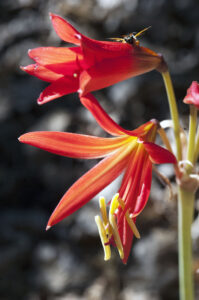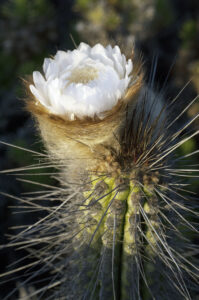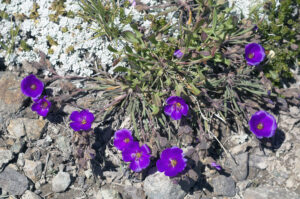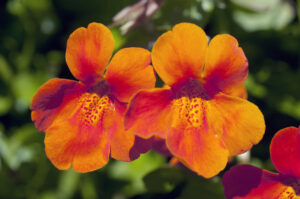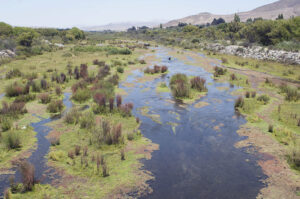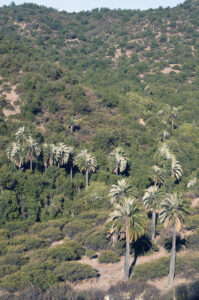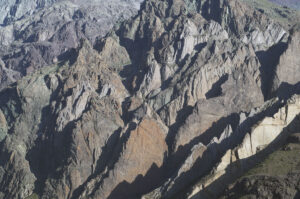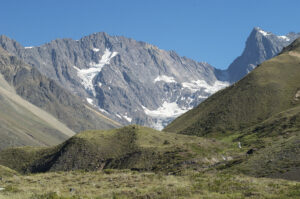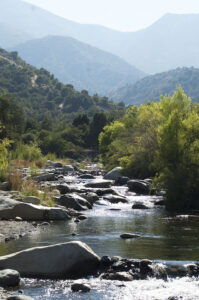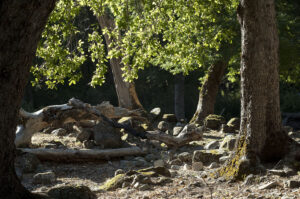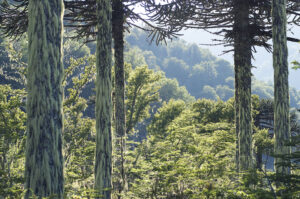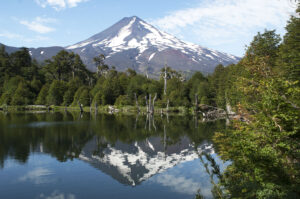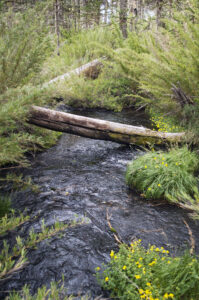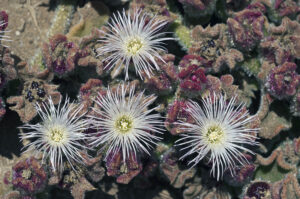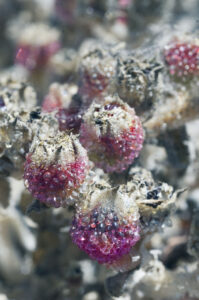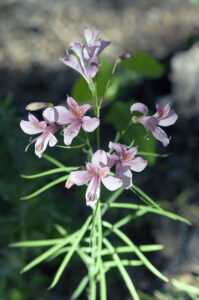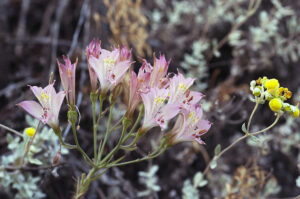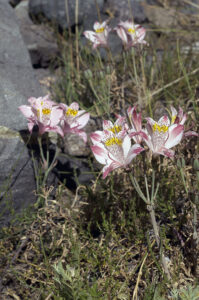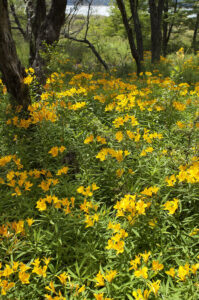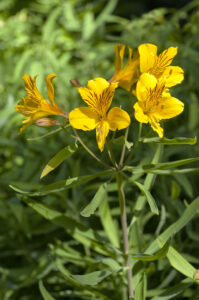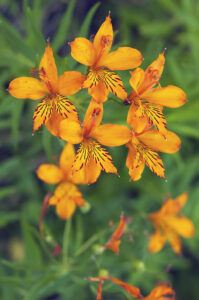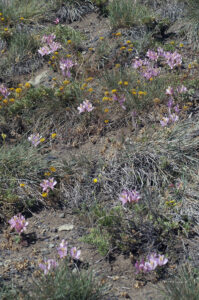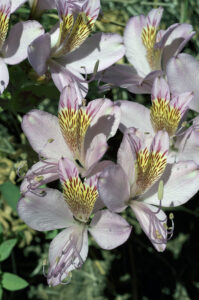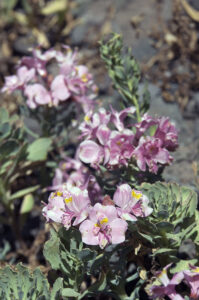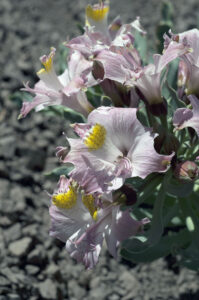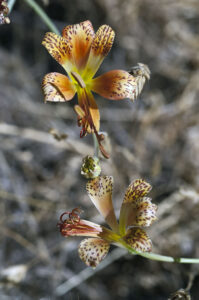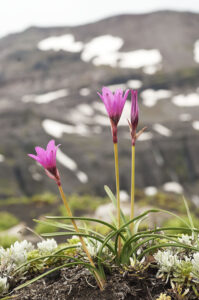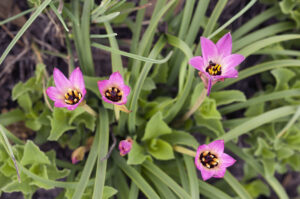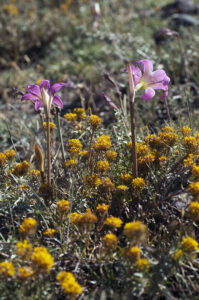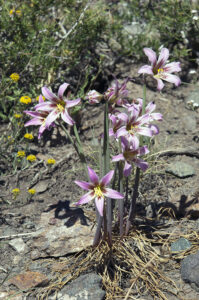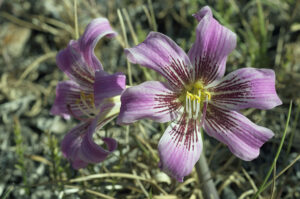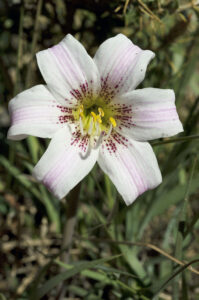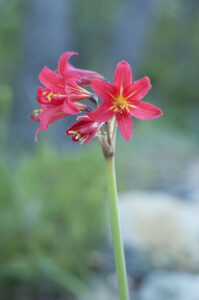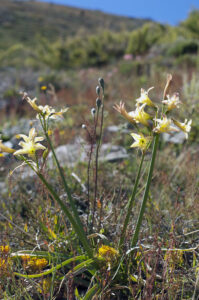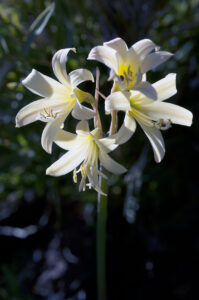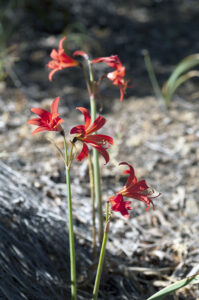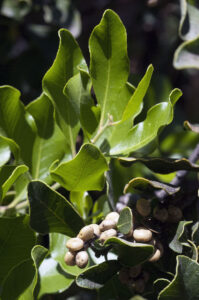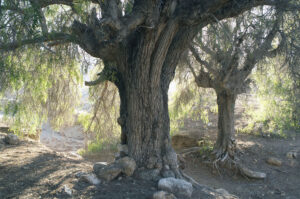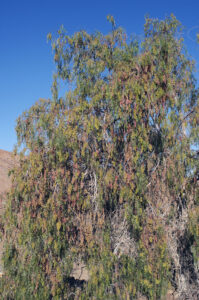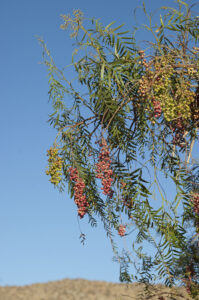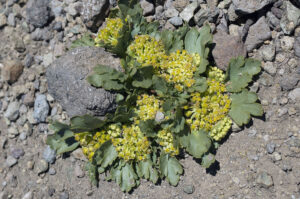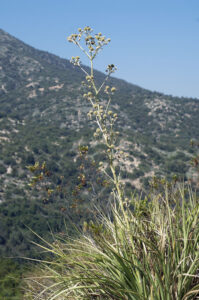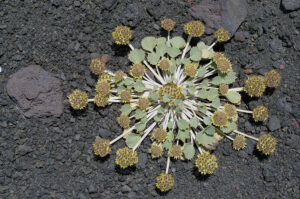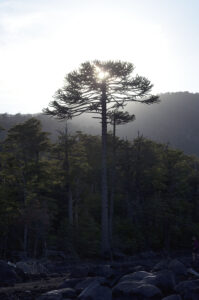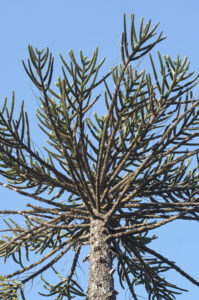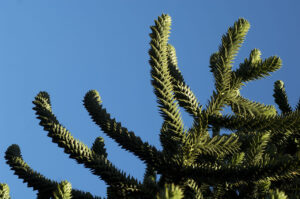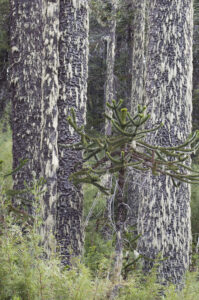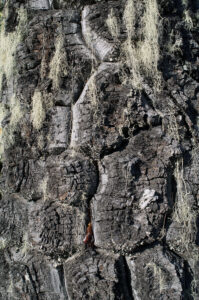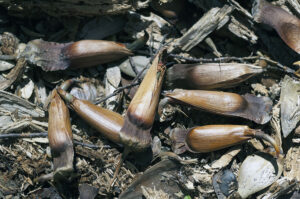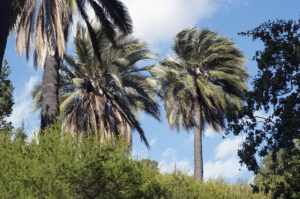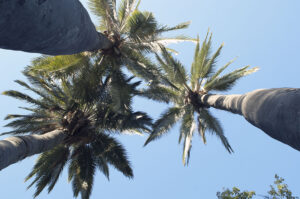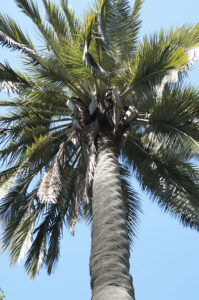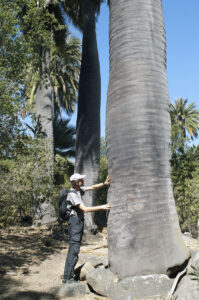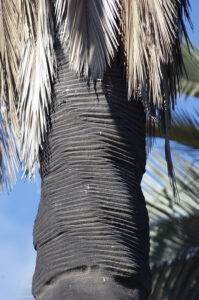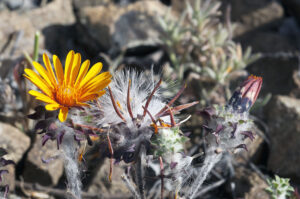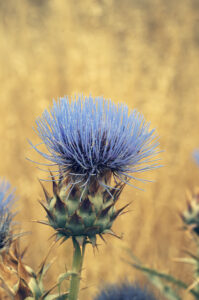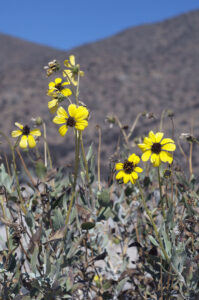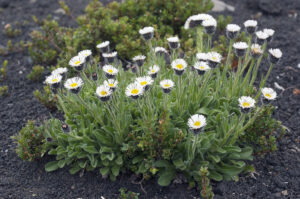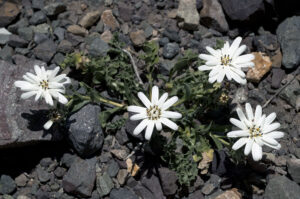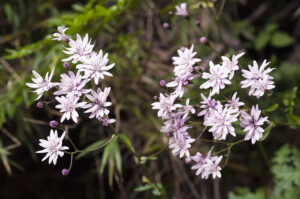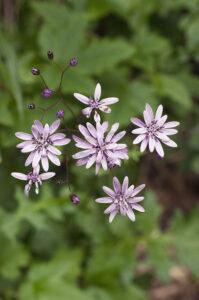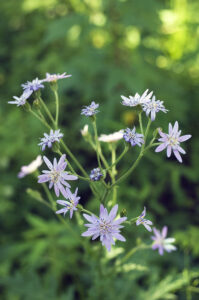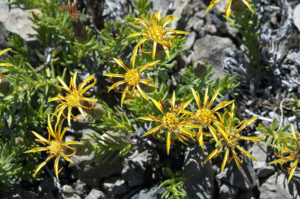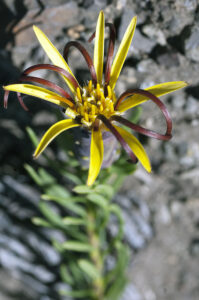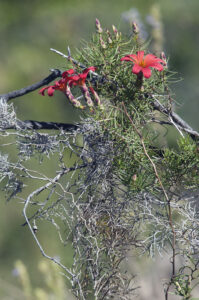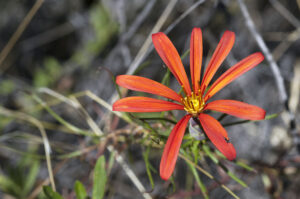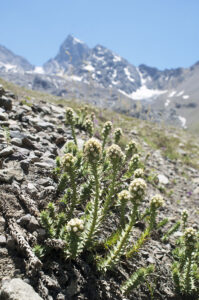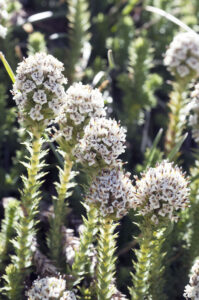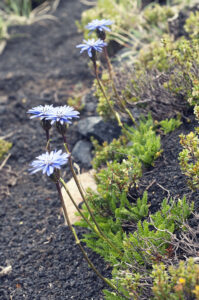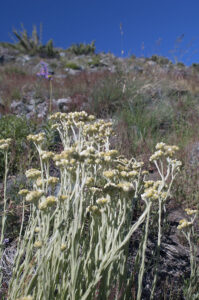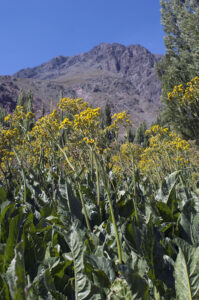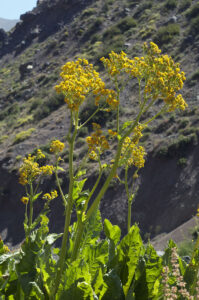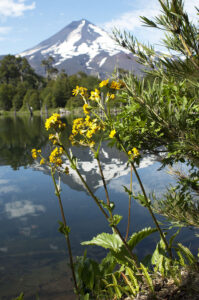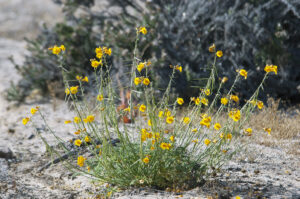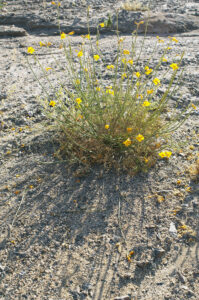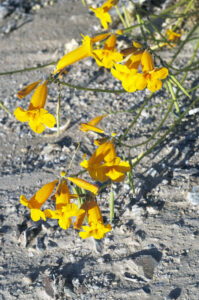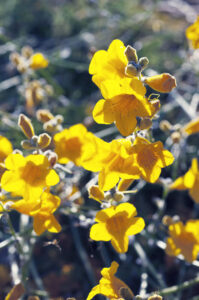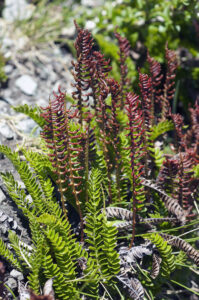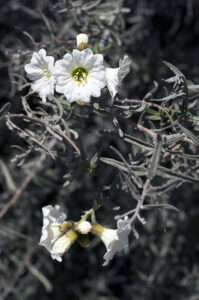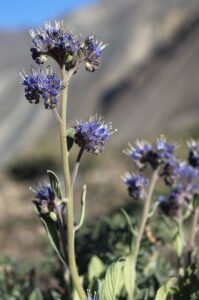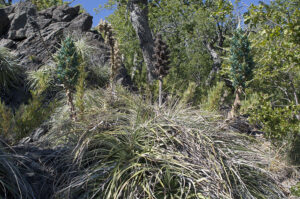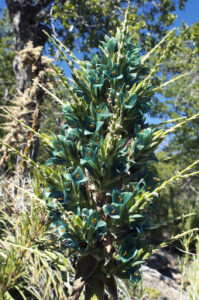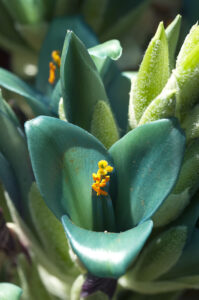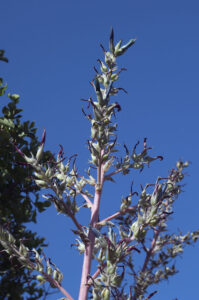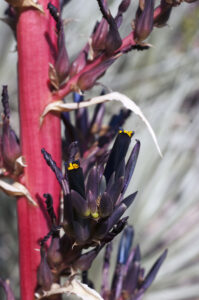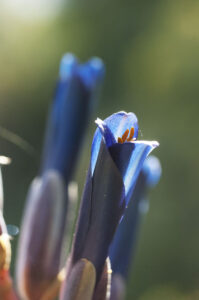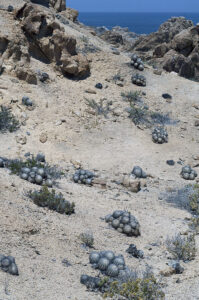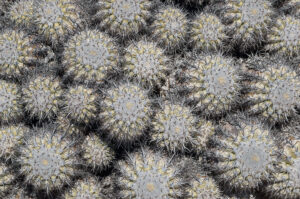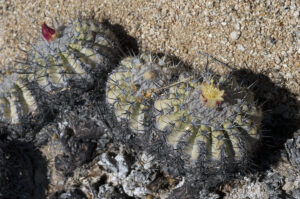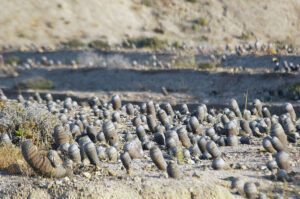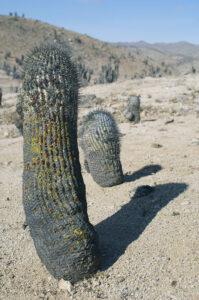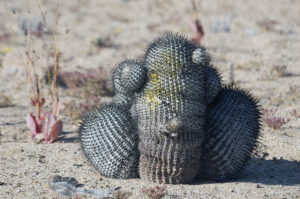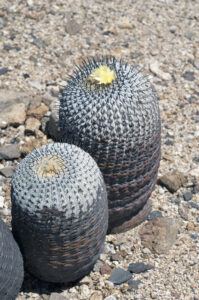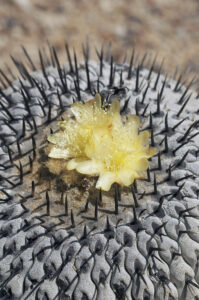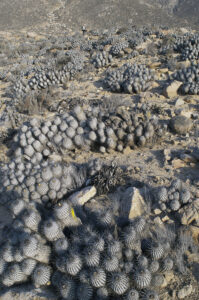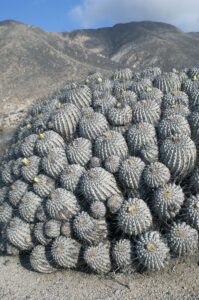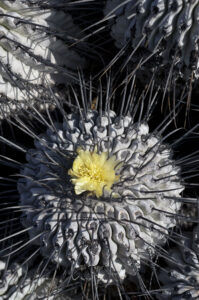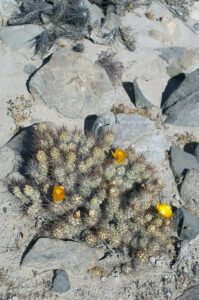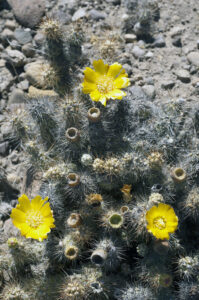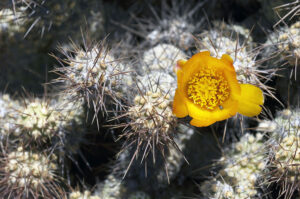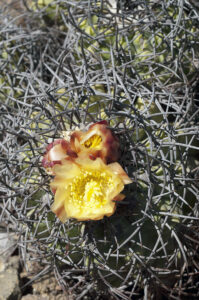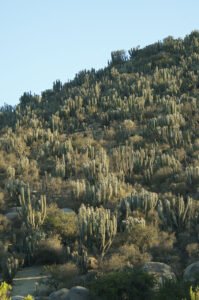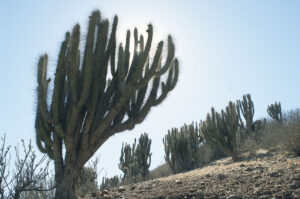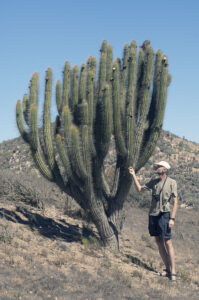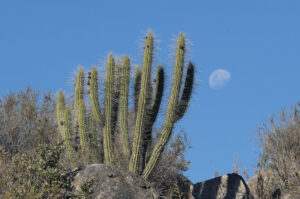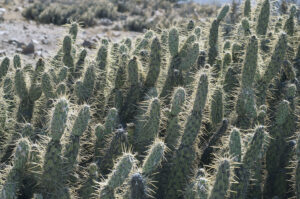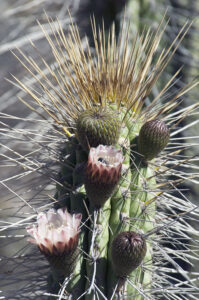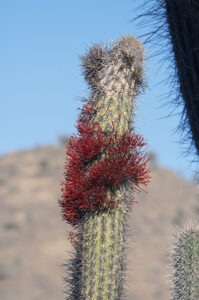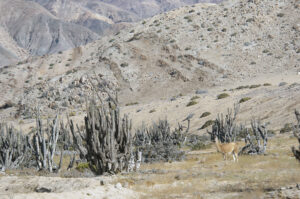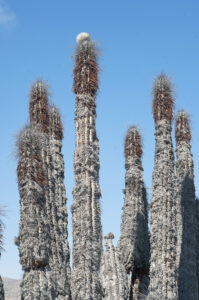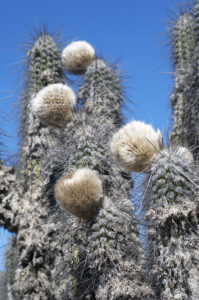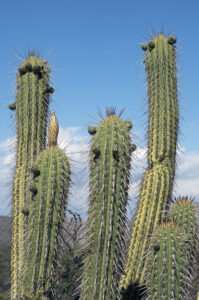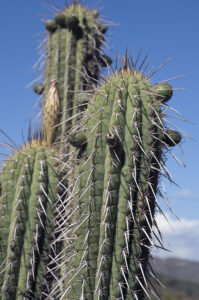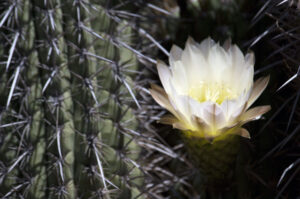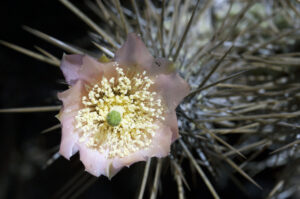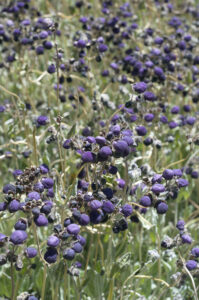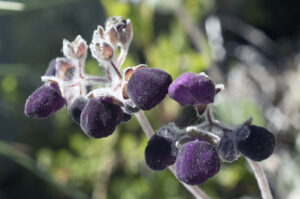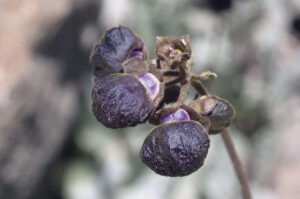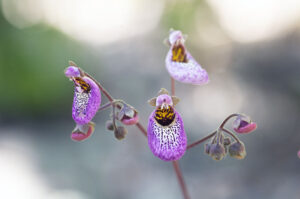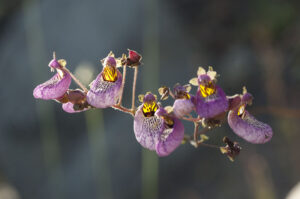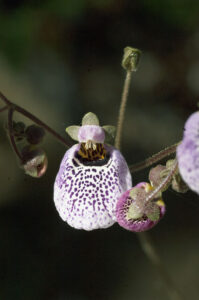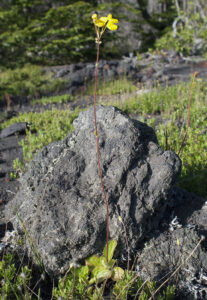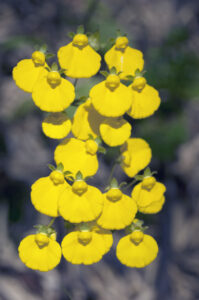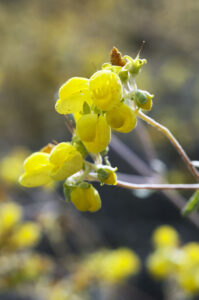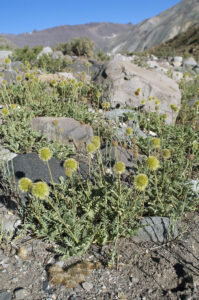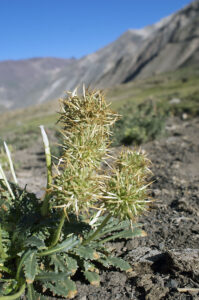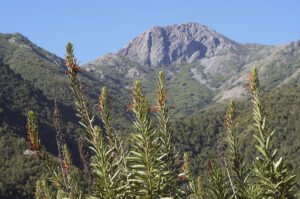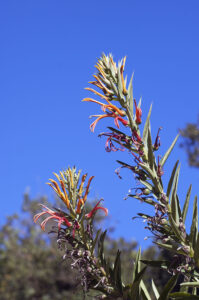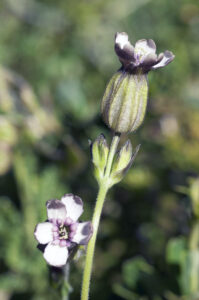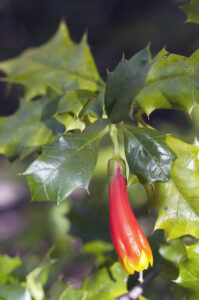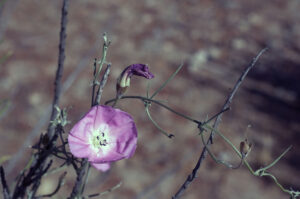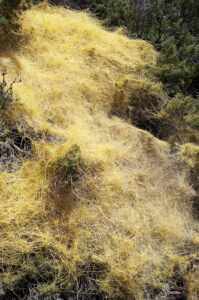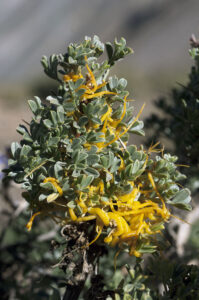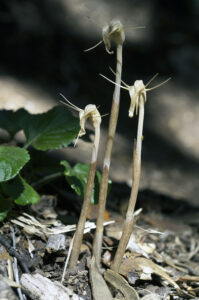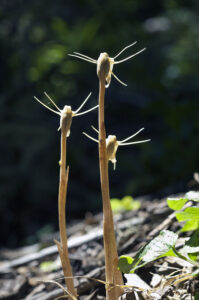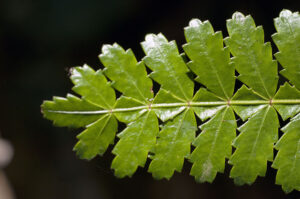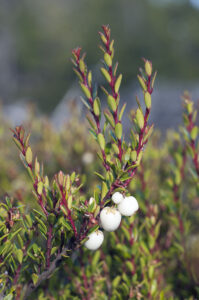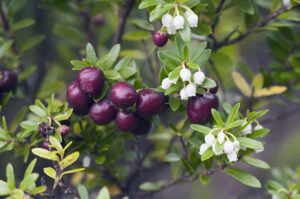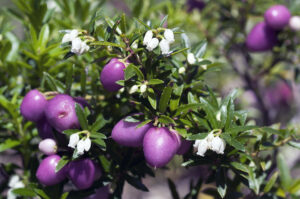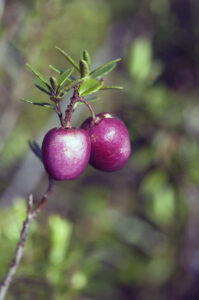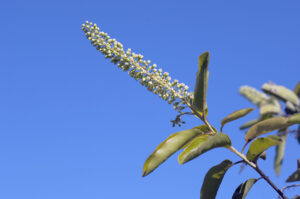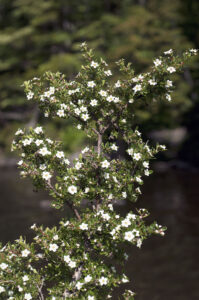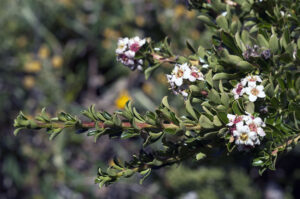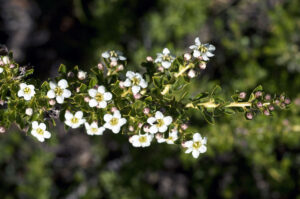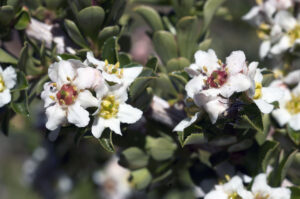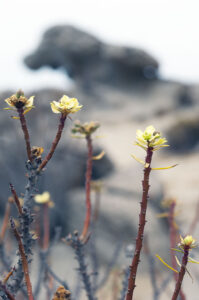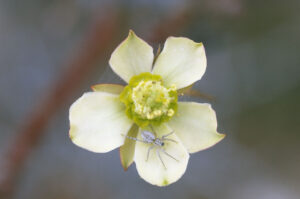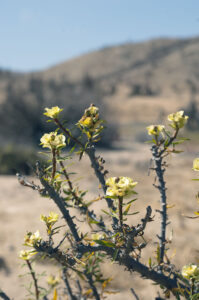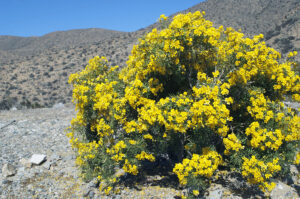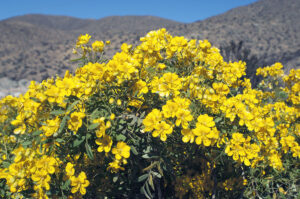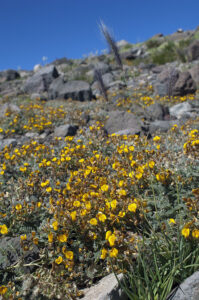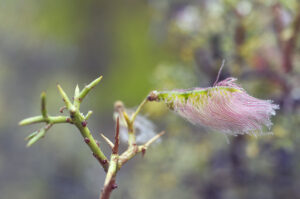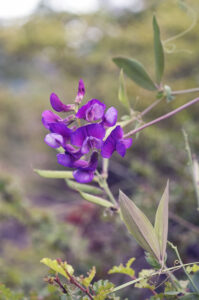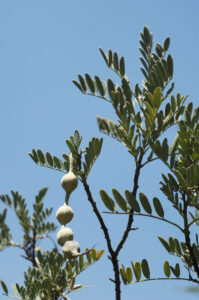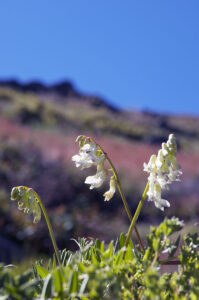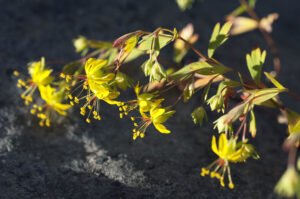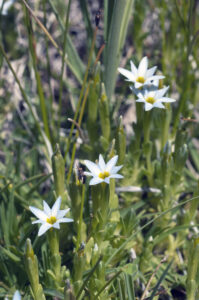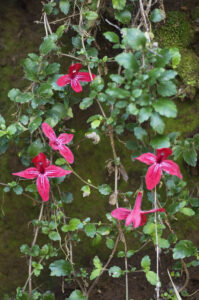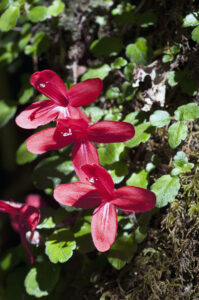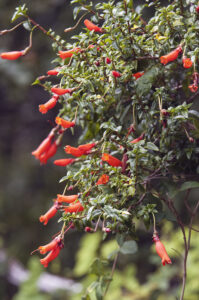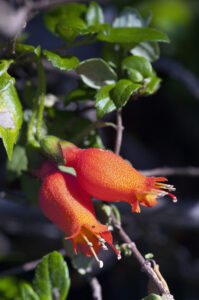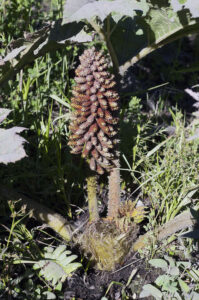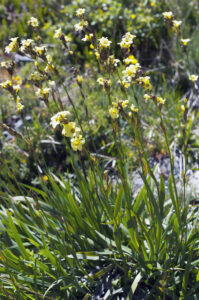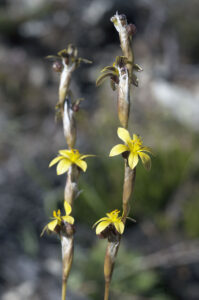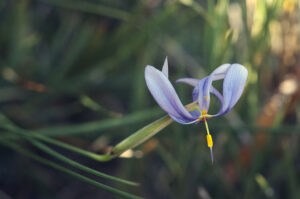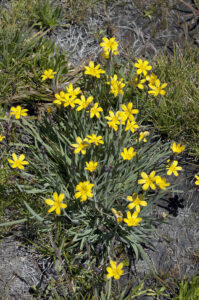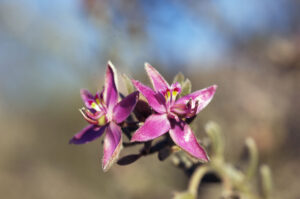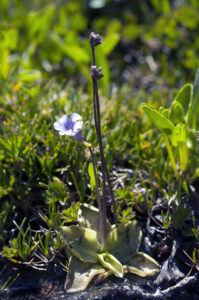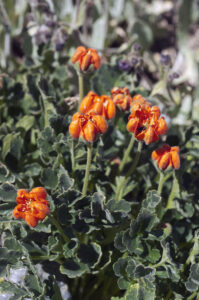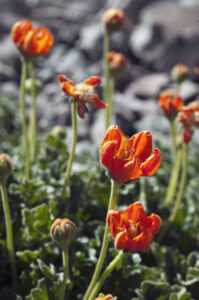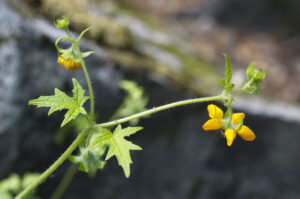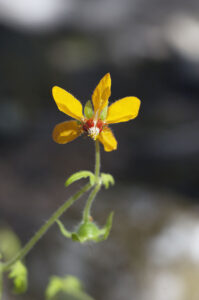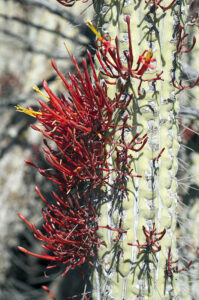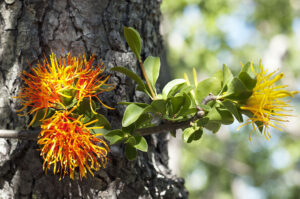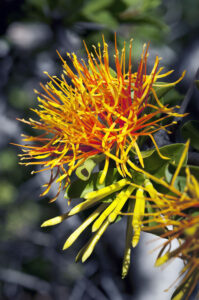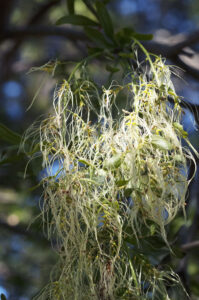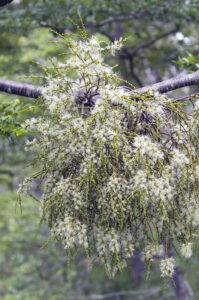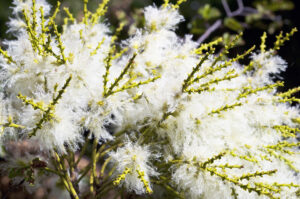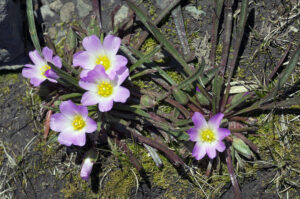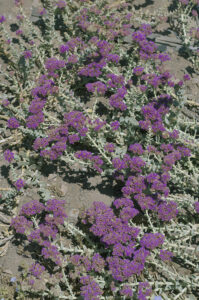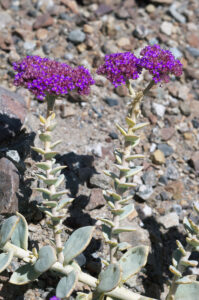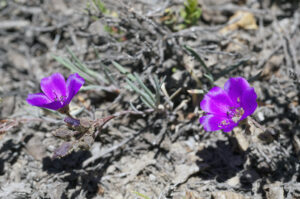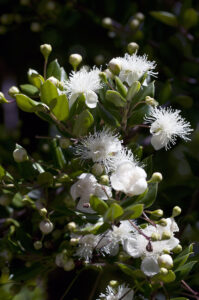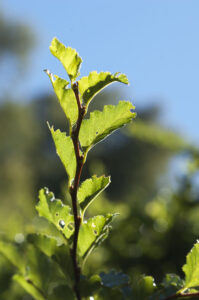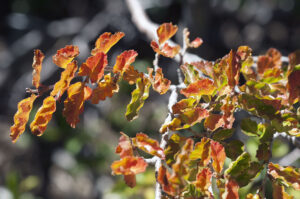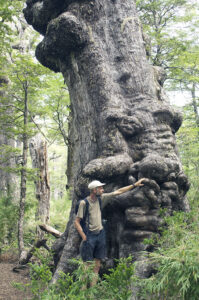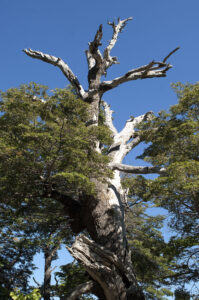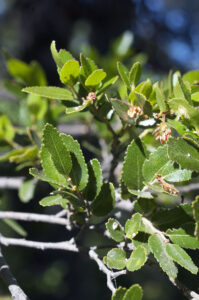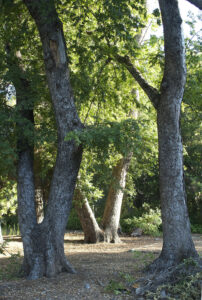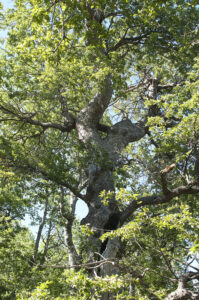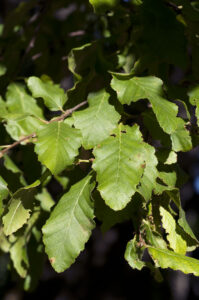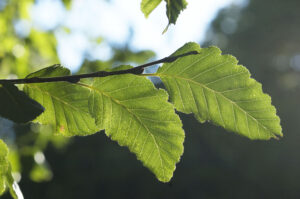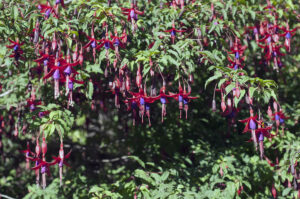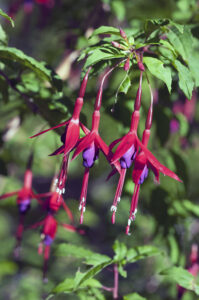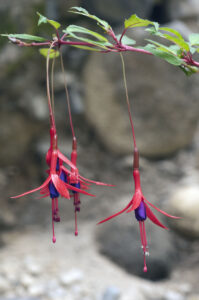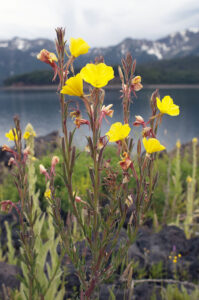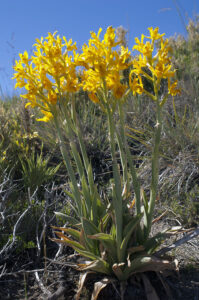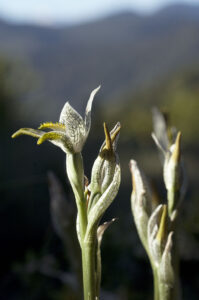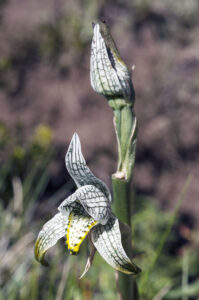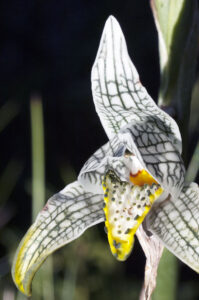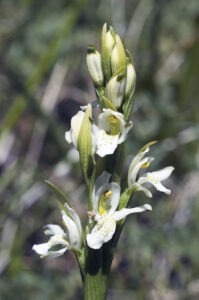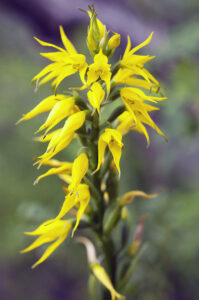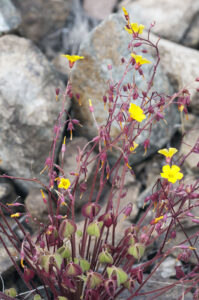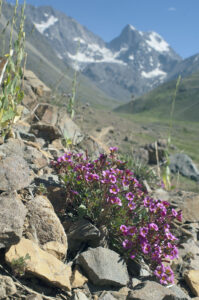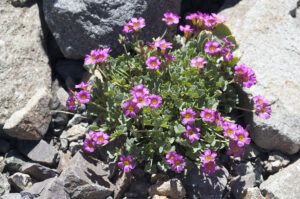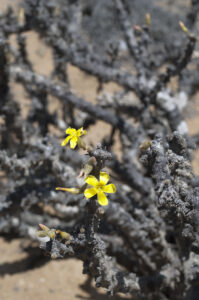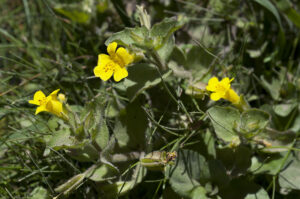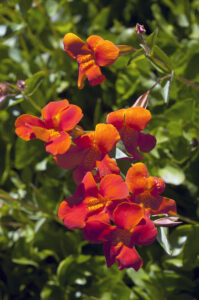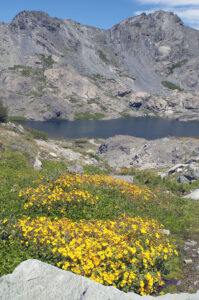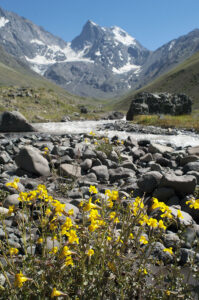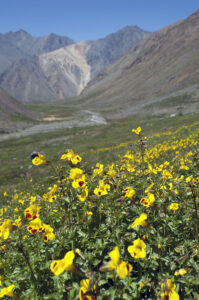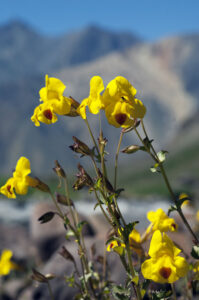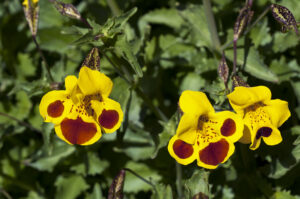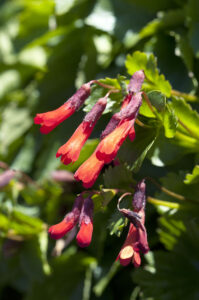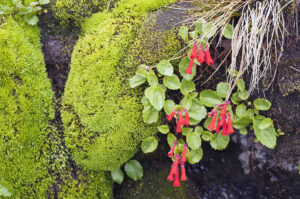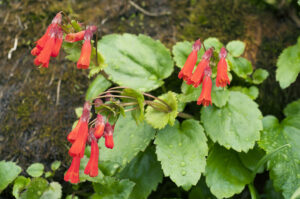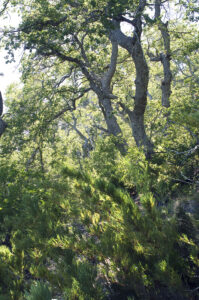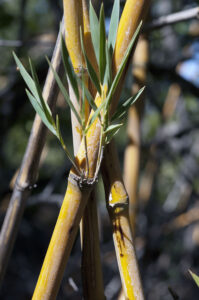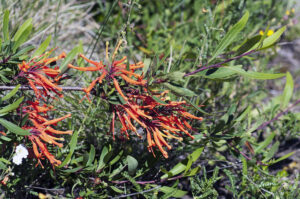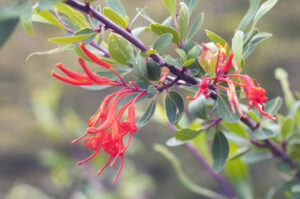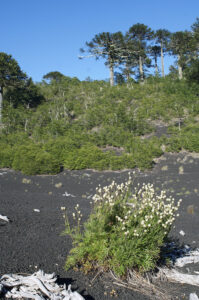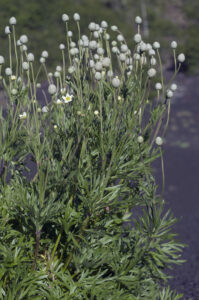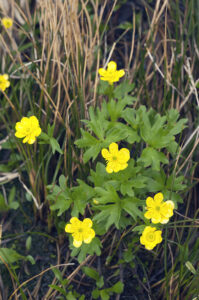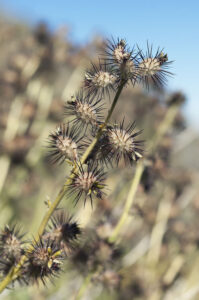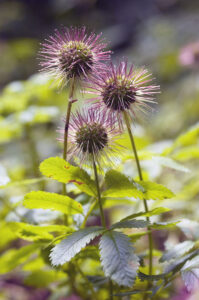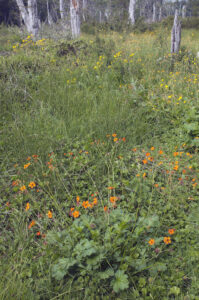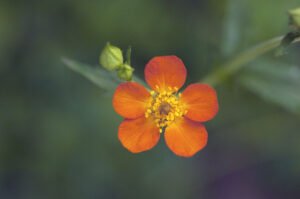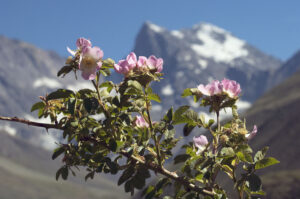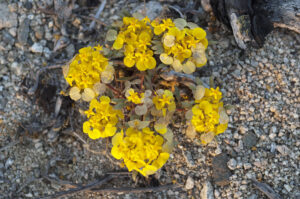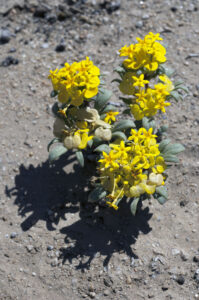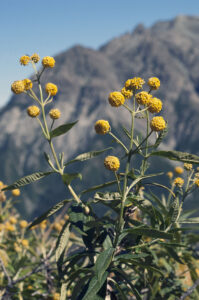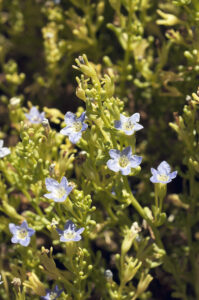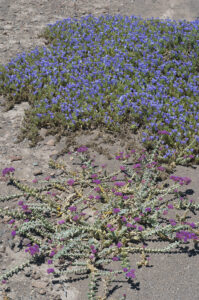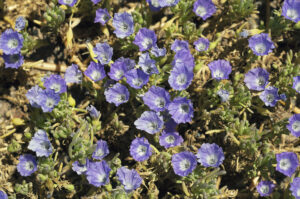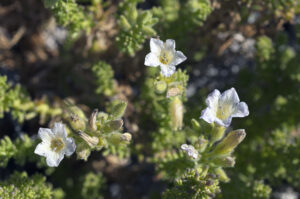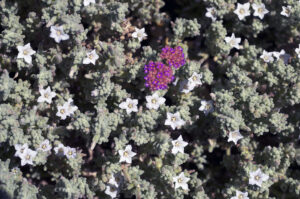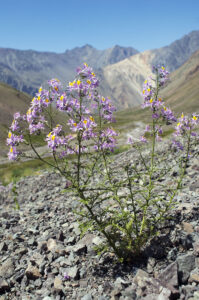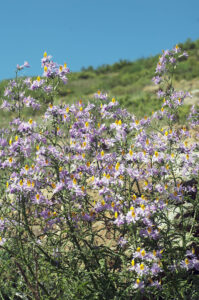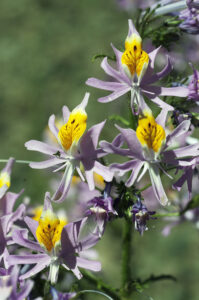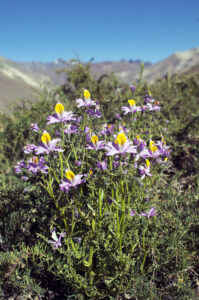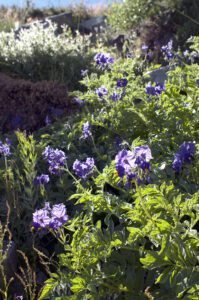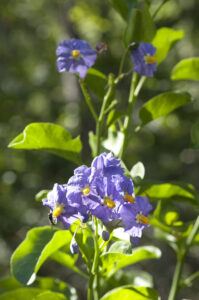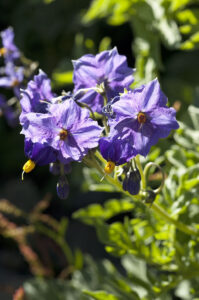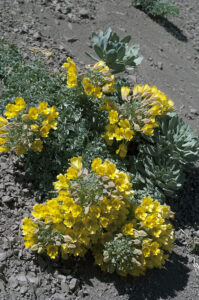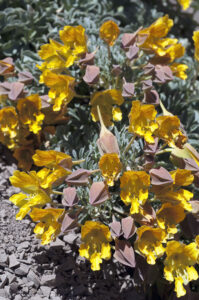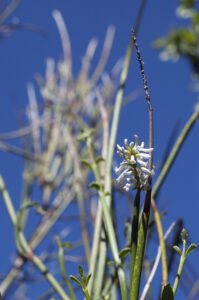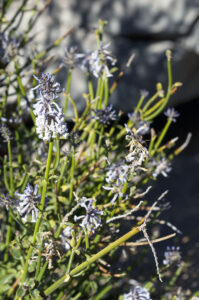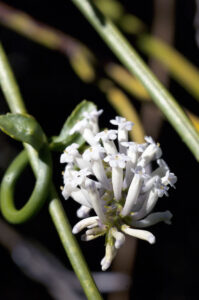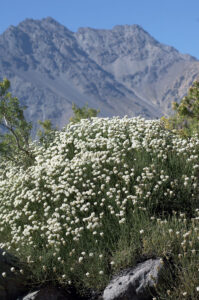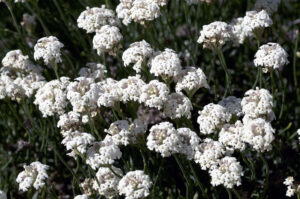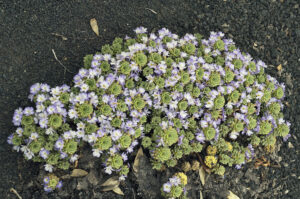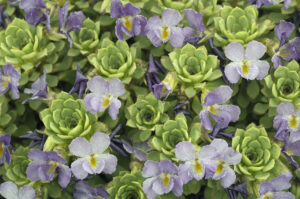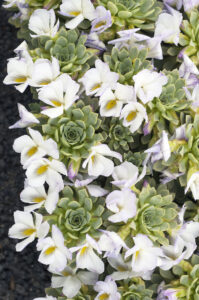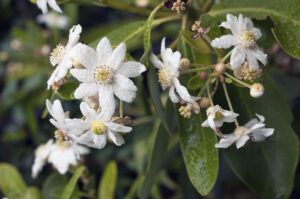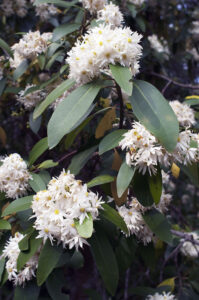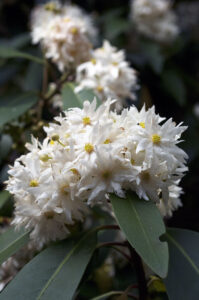Flora in Chile
Zephyranthes splendens, Reserva Nacional Altos de Lircay. Note the wasp. (Photo copyright © by Kaj Halberg)
Flowers of copao (Eulychnia acida) are white or pink. – Llanos de Challe National Park. (Photo copyright © by Kaj Halberg)
An unidentified species of Cistanthe, Reserva Nacional Altos de Lircay. (Photo copyright © by Kaj Halberg)
Erythranthe cuprea, Reserva Nacional Altos de Lircay. (Photo copyright © by Kaj Halberg)
Chile occupies a long, narrow strip of land between the Andes to the east and the Pacific Ocean to the west, covering about 750,000 square km. The enormous length of the country – more than 4,300 km – means that climate and landscape are very diverse, ranging from the world’s driest desert, the Atacama, in the north, through a Mediterranean climate in the centre, to an oceanic climate with alpine tundra and glaciers to the east and south.
The Atacama Desert and the Andes are functioning as barriers, which have led to isolation of flora and fauna, which again has caused a high degree of endemism.
The native flora of Chile contains relatively few species, compared to that of the neighbouring countries. The Atacama Desert is home to a large number of cacti and other plants, of which the majority are endemic to the country. Further south are forests, dominated by Araucaria and southern beeches (Notofagus), and in the southernmost part, south of the Biobío River, the climate is very wet, producing lush forests. Grasslands are found some places in the High Andes, and in the Chilean part of Patagonia.
The following pictures show the great diversity of the Chilean landscape.
Desert with Iquique copao (Eulychnia iquiquensis) and the cactus species Copiapoa cinerea (ssp. columna-alba), Pan de Azucar National Park, Atacama, northern Chile. (Photo copyright © by Kaj Halberg)
Desert in Valle de la Luna National Park, Atacama. (Photo copyright © by Kaj Halberg)
Eroded desert mountains in morning light, east of the coastal city of Antofagasta, Atacama. (Photo copyright © by Kaj Halberg)
Huasco River, near the coastal town of Huasco, central Chile. (Photo copyright © by Kaj Halberg)
Shrub forest with Chilean palm (Jubaea chilensis), La Campana National Park, central Chile. (Photo copyright © by Kaj Halberg)
Eroded mountain slope and grazing horses, near the reservoir Embalse El Yeso (2560 m), Andes, central Chile. (Photo copyright © by Kaj Halberg)
Eroded mountains, Banos Morales, near Monumento Natural El Morado, central Chile. (Photo copyright © by Kaj Halberg)
Alpine grassland, Monumento Natural El Morado. A large growth of Erythranthe lutea, a species of monkey-flower, is seen in the lower picture. (Photos copyright © by Kaj Halberg)
Rio Clarillo, Reserva Nacional Rio Clarillo, central Chile. (Photo copyright © by Kaj Halberg)
Forest with coigue (Nothofagus dombeyi), a species of southern beech, Reserva Nacional Altos de Lircay, central Chile. (Photo copyright © by Kaj Halberg)
Forest of pehuen (Araucaria araucana) and coigue (Nothofagus dombeyi), Conguillio National Park, central Chile. Numerous lichens are growing on the pehuen trunks. (Photo copyright © by Kaj Halberg)
Lago Captren, Conguillio National Park. The Llaima Volcano (3125 m) is seen in the background. (Photo copyright © by Kaj Halberg)
Lush growth of Chilean weeping bamboo (Chusquea quila) along a stream, Conguillio National Park. The plants with yellow flowers are a species of monkeyflower (Erythranthe). (Photo copyright © by Kaj Halberg)
This page deals only with the flora of the northern and central parts of Chile. The pictures were taken during a one month’s stay in January 2011, together with Lars Skipper. The plants are arranged alphabetically according to family name, genus name, and specific name.
I would be grateful to receive information on any errors, or if you are able to identify any of the species left unidentified. You may use this address: respectnature108@gmail.com.
Aizoaceae Ice plant family, midday flower family
This large family contains about 135 genera and 1,800 species of succulents, almost all endemic to arid areas in southern Africa. A few species are found in the Mediterranean area, Australia, New Zealand, some Pacific islands, and North America.
The family name is derived from Ancient Greek aeizoon (‘houseleek’), from aei (‘forever’) and zoion (‘a living thing’), alluding to the succulent, long-living leaves of the members, similar to the houseleeks (Sempervivum).
Mesembryanthemum Ice plant, midday flower
A large genus of about 100 species, native from the Mediterranean eastwards to Iran, from the Sahara eastwards to the Arabian Peninsula, and in southern Africa.
Many members have glistening bladder cells covering their stems, fruit and leaves, giving rise to the popular name ice plant. The main function of these cells is to preserve water.
The name midday flower stems from Polish merchant and naturalist Jacob Breyne (1637-1697), who named the genus in 1684, using the spelling Mesembrianthemum, derived from the Greek mesembria (‘noon’) and anthemon (‘flower’), thus ‘midday flower’. He had noticed that these plants mostly opened the flowers around noon.
In 1719, however, German botanist Johann Jacob Dillenius (1684-1747) discovered that some members were flowering at night, so he changed the spelling to Mesembryanthemum, derived from the Greek mesos (‘middle’), embryon (‘pistil’), and again anthemon (‘flower’), thus ‘flower with the pistil in the centre’.
Mesembryanthemum crystallinum Crystalline ice plant
A prostrate, succulent plant, native from the Mediterranean southwards to Mauritania, in the Arabian Peninsula, and in southern Africa. It has also become naturalized in the Americas and Australia. The plant is covered with glistening bladder cells, which have given rise to the specific and common names.
The leaves are edible, and in southern Africa leaves and stems are pickled.
Crystalline ice plant, Llanos de Challe National Park (top) and Huasco. (Photos copyright © by Kaj Halberg)
Alstroemeriaceae
A family with 4 genera and about 255 species, almost all native to Central and South America.
Alstroemeria Peruvian lily, Inca lily
These plants, comprising about 120 species, are all native to South America, with most species in central Chile and eastern Brazil. All are perennials, except A. graminea, a diminutive annual from the Atacama Desert. Some species have become naturalized in the United States, Mexico, Australia, New Zealand, Madeira, and the Canary Islands.
The genus was named by Swedish naturalist Carl Linnaeus (1707-1778) in honour of his friend, baron Clas Alströmer (1736-1794), who travelled throughout southern Europe 1760-64, collecting plants for Linnaeus. He established a botanical garden and natural museum near Gothenburg, western Sweden.
An unidentified species of Alstroemeria, Reserva Nacional Altos de Lircay. (Photo copyright © by Kaj Halberg)
Alstroemeria angustifolia
This species is restricted to central and northern Chile, found at elevations between 500 and 2,000 m.
The specific name is Latin, meaning ‘narrow-leaved’.
Alstroemeria angustifolia, La Campana National Park. A species of slipper flower, Calceolaria polifolia, is also seen. (Photo copyright © by Kaj Halberg)
Alstroemeria angustifolia, Monumento Natural El Morado. (Photos copyright © by Kaj Halberg)
Alstroemeria aurea
This gorgeous plant often forms large growths. The stem is to 1.5 m tall, leaves lanceolate, to 10 cm long, flower colour usually golden-yellow or orange in wild populations, but many other colours in cultivated forms.
It is distributed in central and southern Chile and southern Argentina, found up to elevations around 1,500 m. Formerly, it was utilized medicinally.
The specific name is Latin, meaning ‘golden’, alluding to the flower colour.
Yellow form of Alstroemeria aurea, Conguillio National Park. (Photos copyright © by Kaj Halberg)
Orange form of Alstroemeria aurea, Huerquehue National Park. (Photo copyright © by Kaj Halberg)
Alstroemeria exserens
This plant is restricted to the Andes in central Chile and adjacent areas of Argentina, growing at elevations between 900 and 2,200 m.
Together with A. umbellata below, it was among the plants described by Prussian physician and botanist Franz Julius Ferdinand Meyen (1804-1840), who participated in an expedition to South America 1830-1832, related in his book Reise um die Erde ausgeführt auf dem Königlich Preussischen Seehandlungs-Schiffe Prinzess Louise, commandirt von Captain W. Wendt, in den Jahren 1830, 1831 und 1832 (‘Journey around the world, executed on board the Royal Prussian maritime merchant ship Prinzess Louise, commanded by Captain W. Wendt, in the years 1830, 1831, and 1832′).
He also described a number of animals new to science, including the Humboldt penguin (Spheniscus humboldti).
The specific name is Latin, meaning something like ‘to uncover’, perhaps alluding to the hardiness of this plant, which often grows in places that have been covered by a thick layer of snow for months.
Alstroemeria exserens, Reserva Nacional Altos de Lircay. (Photos copyright © by Kaj Halberg)
Alstroemeria umbellata
This low plant, growing to 30 cm tall, is characterized by its succulent leaves. It is restricted to the Andes in central Chile and adjacent areas of Argentina, growing at elevations between 1,400 and 3,000 m.
The specific name is Latin, meaning ‘with an umbel’, alluding to the inflorescence.
Alstroemeria umbellata, Monumento Natural El Morado. (Photo copyright © by Kaj Halberg)
Alstroemeria umbellata, Embalse El Yeso, Andes. (Photo copyright © by Kaj Halberg)
Alstroemeria versicolor
This spectacular plant, growing to 30 cm tall, is endemic to central Chile, found at altitudes between 250 and 1,700 m. The root is a source of nutritious starch. The fresh sap can cause skin rashes in some people.
The specific name is Latin, meaning ‘with various colours’, alluding to the speckled flowers.
Alstroemeria versicolor, Reserva Nacional Rio Clarillo. (Photos copyright © by Kaj Halberg)
Amaryllidaceae Amaryllis family
A family with about 75 genera and 1,600 species, mainly found in tropical and subtropical areas around the world.
Rhodolirium
This small genus, comprising 2-6 species, depending on authority, is distributed in northern and central Chile and western Argentina, growing up to elevations around 2,500 m.
Previously, these plants were included in the genus Hippeastrum, and later Rhodophiala, whose members have been moved to other genera, including Zephyranthes (below).
The generic name is derived from Ancient Greek rhodon (‘rose’) and leirion (‘lily’, ‘narcis’), referring to the beautiful flowers.
Rhodolirium andicola
This small plant, to 25 cm tall, is restricted to the Andes of central Chile and adjacent areas of Argentina. It often grows in old lava fields. It has rather fleshy, linear leaves, and small, pinkish-red flowers with pointed petals.
The specific name is derived from Andes and the Latin colo (‘to inhabit’).
Rhodolirium andicola, Conguillio National Park. The plants with white flowers in the upper picture are Viola cotyledon. (Photos copyright © by Kaj Halberg)
Rhodolirium montanum
This species has about the same distribution as the above species, but grows at slightly lower elevations. It is a larger plant, with larger flowers, and the petals are broader, strap-shaped, pink or whitish.
The flowers of Rhodolirium montanum may be pink or white, or a combination of the two, but always with purple spots or streaks near the centre. – Monumento Natural El Morado. (Photos copyright © by Kaj Halberg)
Zephyranthes
There is much controversy as to placement of members of the genus Rhodophiala, which is no longer accepted in Plants of the World Online (Kew Gardens), where they have been moved to the genera Phycella and Zephyranthes. Other authorities still accept Rhodophiala as a valid genus.
Today, Zephyranthes, according to Plants of the World Online, contains about 185 species, found in tropical and subtropical America.
The generic name is derived from Zephyrus, the Greek God of the West Wind, who re-awakened nature every spring, and anthos (‘flower’).
An unidentified species of Zephyranthes, Reserva Nacional Altos de Lircay. (Photo copyright © by Kaj Halberg)
Zephyranthes montana
This species, to 35 cm tall, is easily identified by its pale yellow flowers. It is restricted to central Chile, found at moderate altitudes in the Andes.
Zephyranthes montana, Reserva Nacional Altos de Lircay. (Photos copyright © by Kaj Halberg)
Zephyranthes splendens
This plant, which is also endemic to central Chile, really lives up to its specific name. The flowering stem is to 40 cm tall, the gorgeous flowers appearing before the linear leaves, which grow to 40 cm long and 1 cm wide.
The specific name is Latin, meaning ‘brilliant’ or ‘gorgeous’.
Zephyranthes splendens, Reserva Nacional Altos de Lircay. Another picture of this species may be seen at the top of this page. (Photo copyright © by Kaj Halberg)
Anacardiaceae Cashew or sumac family
A cosmopolitan family with about 83 genera and 860 species, mainly found in tropical regions, with some members in subtropical and temperate areas.
Lithraea
A small genus with 3 species, native to Bolivia, Brazil, Paraguay, Uruguay, Chile, and Argentina.
Lithraea caustica
An evergreen shrub to 6 m tall, older specimens with a contorted trunk, to 50 cm in diameter, branching from below, with furrowed bark. Leaves are ovate to rounded, shining, to 5.6 cm long and 3.3 cm wide, margin entire and undulating, veins prominent. Inflorescences are axillary clusters, to 6 cm long, flowers yellowish-green. The fruit is a drupe, to 8 mm long, yellowish-white and shiny.
This species is endemic to central Chile, growing in dry shrubland in coastal mountains and in the lower foothills of the Andes.
The plant lives up to its specific name, as its sap is caustic and can cause a rash of the skin.
Lithraea caustica with fruits, Reserva Nacional Rio Clarillo. (Photo copyright © by Kaj Halberg)
Schinus Pepper trees
The native range of this genus, comprising about 33 species of trees and large shrubs, is from Peru and Brazil southwards to southern South America.
The generic name is derived from the Greek skhinos, the ancient name of another member of the family, Pistacia lentiscus.
Schinus molle Peruvian pepper tree
This evergreen tree, growing to 15 m tall, is native to Peru, northern Chile, north-eastern Argentina, and southern Brazil. However, due to its strong wood, which was once much utilized for saddles, it has been widely introduced elsewhere. It has become naturalized in many places, and is regarded as a serious invasive weed in South Africa, Australia, Florida, and Hawaii.
Its pinkish-red fruits are sold as ‘pink peppercorns’, and they have been used as a flavouring agent in drinks and syrups. However, there has been records of small children experiencing vomiting and diarrhea after eating them. The leaves may also be poisonous. In traditional medicine, the species has been used for wounds and infections, as a diuretic, and for toothache, rheumatism and menstrual disorders.
The specific name is a corruption of mulli, the Quechua name of the tree.
Peruvian peppertrees, south of Vallenar. (Photos copyright © by Kaj Halberg)
Apiaceae (Umbelliferae) Carrot family
A huge worldwide family, containing about 434 genera with c. 3,700 species of herbs.
The inflorescence of this family is unique. In almost all species, the flowers are arranged in terminal umbels, which may be simple, usually with bracts at the base, and each of the stalks, the so-called primary rays, ending in a flower. More commonly, the umbel is compound, consisting of a number of primary rays, each ending in a secondary umbel. Each of these umbels usually has small bracts, bracteoles, at the base, and a number of secondary rays, each ending in a flower. Usually, the secondary umbels together form a flat-topped inflorescence, mostly with white, yellow, pink, or purple flowers, rarely blue or bright red. The flowers have five petals and stamens. This also accounts for the sepals, if they are present. They are usually missing, however.
The family name is derived from the name of honey bees, genus Apis, referring to the fact that many plants of the family are much visited by bees and other nectar-sucking insects, in particular hovering flies.
Azorella
A genus with about 55 species, found from Costa Rica and Venezuela southwards along the Andes to Tierra del Fuego, and also in south-eastern Australia and New Zealand.
Azorella diversifolia
A prostrate plant, leaves clustered in a basal rosette, obovate, with a wedge-shaped base, to 5 cm long and 2.5 cm wide, with 3-5 lobes. The umbels, which contain numerous yellow flowers, are hugging the ground.
This species is distributed in central and southern Chile and southern Argentina.
Azorella diversifolia, Reserva Nacional Altos de Lircay. (Photo copyright © by Kaj Halberg)
Eryngium Eryngo, sea holly
This genus, comprising about 250 species, has an almost cosmopolitan distribution, with a core area in South America. Most species are quite spiny, especially the bracts surrounding the inflorescence.
Eryngium paniculatum
This tall plant, growing to a height of about 2 m, is found from south-eastern Brazil southwards to central Chile and Argentina. The greyish-green, strap-shaped leaves, up to 30 cm long and 3 cm broad, with a spiny margin, are arranged in a basal rosette, from which an erect flowering stem grows, branching near the top. The numerous flowerheads are globular, to 3 cm across, flowers whitish-green.
The roots of this plant may survive fire, enabling it to regenerate. The species is noted for being an aggressive invader of grazing grounds.
Eryngium paniculatum, Reserva Nacional Rio Clarillo. (Photo copyright © by Kaj Halberg)
Pozoa
A small genus with only 2 species, native to central and southern Chile and adjacent areas of Argentina.
Pozoa coriacea
A prostrate plant, to 15 cm tall, leaves gathered in a rosette, rounded or kidney-shaped, leathery, to 3 cm across, pale greyish-green with yellowish, strongly toothed margin. Umbels are hemisphaerical, on stems to 25 cm long, flowers reddish-brown to purplish, to 3 mm across.
This plant grows on bare, sandy or stony soil, often on volcanic slopes or among scree, at altitudes between 1,000 and 3,700 m. It is native to central Chile and western Argentina.
Pozoa coriacea, growing in black lava sand beneath the Llaima Volcano, Conguillio National Park. (Photo copyright © by Kaj Halberg)
Araucariaceae
An ancient family of large conifers with 3 genera and about 41 species. This family achieved its maximum during the Jurassic and Cretaceous periods, when it was distributed almost worldwide. Today, members are confined to the Southern Hemisphere, except for a few species in Southeast Asia.
The New Zealand kauri tree (Agathis australis) is the third-largest conifer after the North American genera Sequoiadendron and Sequoia (Cupressaceae). All three genera are described in depth on the page Plants: Ancient and huge trees.
Araucaria
Today this genus, comprising 20 species of massive trees, is restricted to the Southern Hemisphere, found in southern South America, Australia, New Zealand, Norfolk Island, and New Caledonia. No less than 14 species are endemic to the latter island.
The generic name is derived from the name of a Chilean people, the Araucanians, for whom the seeds were an important food item. A sub-group of this people are the Pehuenches. In their language, pehuén is the name of Araucaria, whereas che means ’people’.
In English, members of the genus are called monkey-puzzle trees – indeed a peculiar name, as no monkeys live where these trees grow. The name originates from around 1850. In an English park, which had specimens of Araucaria, a visitor jokingly remarked that it would “puzzle a monkey to climb that tree” – referring to the stiff, spiny leaves. The name monkey-puzzle tree stuck to this day.
Araucaria araucana Pehuén
This tree, growing to 40 m tall, with a trunk diameter of up to 1.5 m, is native to central and southern Chile and western Argentina. It is the national tree of Chile, called pehuén.
The leaves are triangular, to 4 cm long and 3 cm broad at the base, very tough and with a sharp point. They can remain on the tree for as long as 15 years, and in time they cover the entire surface of younger branches, only the trunk and old branches being bare.
This species is dioecious, with male and female cones on separate trees. The female cones are wind-pollinated, maturing in about 18 months. The mature cones are very large, 12-20 cm diameter, holding about 200 seeds, each 3-4 cm long. The edible, nut-like seeds are extensively harvested in Chile.
In 1791-95, Scottish naturalist Archibald Menzies (1754-1842) participated as surgeon and botanist in an expedition around the world on board HMS Discovery, under leadership of Captain George Vancouver (1757-1798). In Chile, while dining with the Viceroy, Menzies was served Araucaria seeds as a dessert. He popped some seeds into his pocket and was able to make them sprout on board the ship. He returned to England with five healthy plants – the first of its kind in Britain. (Source: kew.org)
The specific name has the same meaning as the generic name.
Pehuén, Conguillio National Park. (Photos copyright © by Kaj Halberg)
A young specimen of pehuén, growing in front of older trees, whose trunks are covered in Usnea lichens, Conguillio National Park. (Photo copyright © by Kaj Halberg)
The bark on older specimens of pehuén is deeply fissured. In this picture from Conguillio National Park, Usnea lichens are growing on the trunk. (Photo copyright © by Kaj Halberg)
Fallen seeds of pehuén, Huerquehue National Park. (Photo copyright © by Kaj Halberg)
Arecaceae Palm family
This huge family, comprising about 183 genera and c. 2,450 species of trees, shrubs, or climbers, is distributed mainly in tropical and subtropical regions around the world, with a few species extending into temperate areas.
The compound leaves, in most species growing fan-like from the top of the plant, are often very large and decorative. Numerous pictures, depicting palm leaves, may be seen on the page Nature: Nature’s patterns.
Jubaea chilensis Chilean palm
This stately tree, the only member of the genus, is endemic to a small area in central Chile. It may grow to 25 m tall, with a very thick trunk, sometimes up to 1.3 m in diameter. The dark green leaves are pinnate, to 5 m long, with pinnae to 50 cm long.
A stronghold of the Chilean palm is La Campana National Park, where these pictures were taken. (Photos copyright © by Kaj Halberg)
Asteraceae (Compositae) Daisy family
This worldwide family is one of the largest, comprising about 1,620 genera with c. 24,000 species of herbs or shrubs, rarely climbers or trees. The inflorescence consists of many individual flowers, called florets, which are grouped densely together to form a flower-like structure, the flowerhead, technically called the capitulum. The central disc florets are symmetric, and the corolla is fused into a tube. The outer ray florets are asymmetric, the corolla having one large lobe, which is often erroneously called a petal. In some species, ray florets, or sometimes disk florets, are absent.
Chaetanthera
A genus of about 50 species, native to western South America, from Peru southwards to Tierra del Fuego.
An unidentified species of Chaetanthera, La Campana National Park. (Photo copyright © by Kaj Halberg)
Cynara Artichoke thistles
The native area of this genus, comprising about 10 species, is around the Mediterranean and in the Middle East.
Cynara cardunculus Cardoon
This species is native around the western and central Mediterranean, but is cultivated many other places for its edible young flowerheads, known as artichokes. It has become naturalized in numerous countries around the world.
A stout plant, growing to 1.5 m tall, with deeply lobed, heavily spiny leaves, to 50 cm long, with yellow spines to 3.5 cm long. The flowerheads are violet-purple or blue, to 6 cm across.
Cardoon, naturalized in Valle del Encanto, Ovalle. (Photos copyright © by Kaj Halberg)
Encelia Brittlebush
About 20 species of shrubs, growing in deserts of south-western North America and western South America. The genus was named in honour of German clergyman and naturalist Christoph Entzelt (1517-1583), also known as Christophorus Enzelius.
Encelia canescens
A pretty, evergreen shrub, to 80 cm tall, leaves greyish, flowerheads with yellow ray florets and brownish-black disc florets. It is found in Chile, Peru, and Bolivia, growing from the lowlands up to altitudes of about 3,500 m.
Encelia canescens, south of Vallenar. (Photo copyright © by Kaj Halberg)
Erigeron Fleabane
A large genus with a cosmopolitan distribution, comprising about 460 species, with the highest diversity in North America.
The generic name is derived from Ancient Greek eri (‘early in the morning’) and geron (‘old man’), probably in allusion to a tuft of white hairs, appearing on the fruit soon after flowering. The English name stems from an old belief that dried plants of this genus would repel fleas.
An unidentified species of fleabane, growing in volcanic gravel, Conguillio National Park. (Photo copyright © by Kaj Halberg)
Leucheria
A genus with about 50 species, native to western and southern South America, from Peru southwards to Tierra del Fuego, and also in the Falkland Islands.
An unidentified species of Leucheria with white ray florets, Monumento Natural El Morado. (Photo copyright © by Kaj Halberg)
An unidentified species of Leucheria with pink ray florets, Conguillio National Park. (Photos copyright © by Kaj Halberg)
An unidentified species of Leucheria with blue ray florets, Huerquehue National Park. (Photo copyright © by Kaj Halberg)
Mutisia
This genus, comprising about 65 species of erect or climbing shrubs, is native to montane areas of southern South America.
The generic name was applied by Swedish naturalist Carl Linnaeus (1707-1778) in honour of Spanish priest, botanist, and mathematician José Celestino Bruno Mutis y Bosio (1732-1808), who emigrated to Santa Fe de Bogotá in 1761 and later became a significant figure in the Spanish American Enlightenment. From 1783, he was the head of 3 royal expeditions in the area, during which hundreds of plant species were discovered and described. The collected items were stored in a museum, containing about 24,000 dried plants and 5,000 drawings of plants, besides a collection of shells, resins, minerals, and animal skins.
Mutisia linearifolia
This small shrub, to 30 cm tall, is distributed in central Chile and adjacent areas of Argentina, growing in alpine shrublands in the Andes at moderate elevations, up to about 2,000 m.
The leaves are linear, stalkless, to 3 cm long and 3 mm wide, flowerheads with 8-10 pale yellow, very narrow ray florets, to 1.7 cm long and 3 mm wide. It may at once be identified by the long, projecting, scarlet stigmas that are often spiralled.
Mutisia linearifolia, Reserva Nacional Altos de Lircay. (Photos copyright © by Kaj Halberg)
Mutisia subulata
A shrub, to 3 m long, climbing or scrambling over other vegetation. The foliage is very dense, especially towards the base, leaves to 5 cm long, linear, stalkless, leathery, bright green when young, later grey, sometimes with hook-like tendrils. The gorgeous flowerheads have about 10 scarlet, brick-red, orange-red, or rose-coloured ray florets, to 2.8 cm long and 8 mm wide.
This plant is distributed in about the same area as the above species, growing in rocky areas and alpine shrubberies in the Andes, at altitudes between 1,400 and 3,000 m.
The specific name is Latin, meaning ‘resembling an awl’, alluding to the needle-like leaves.
Mutisia subulata, Reserva Nacional Rio Clarillo. (Photos copyright © by Kaj Halberg)
Nassauvia
This genus, comprising about 40 species, is distributed from Bolivia southwards to southern South America, and also in the Falkland Islands.
Nassauvia digitata
A much-branched herb, erect, stems densely leafy, to 30 cm tall, leaves bright green, obovate, to 7 mm long and 5 mm wide, with 3-5 sharp teeth. The inflorescence is a terminal spike to 3 cm long and 1.5 cm wide, with numerous small, tightly packed flowerheads.
This species is distributed in the southern central Andes, in Chile and Argentina, growing on rocky slopes at elevations between 2,000 and 2,700m.
Nassauvia digitata, Monumento Natural El Morado. (Photo copyright © by Kaj Halberg)
Nassauvia digitata, Reserva Nacional Altos de Lircay. (Photo copyright © by Kaj Halberg)
Perezia
A genus with about 35 species, distributed in South America, especially in central and southern Andes, a majority growing at high elevations. Some species have been utilized in local traditional medicine, for instance for haemorrhage and inflammation, and as a sedative.
The genus was named for 16th-Century Spanish apothecary and botanist Lázaro (or Lorenzo) Perez.
An unidentified species of Perezia, Conguillio National Park. (Photo copyright © by Kaj Halberg)
Pseudognaphalium Cudweed
A genus of about 110 species, distributed almost globally, mainly in temperate areas, with core areas in the Americas. These plants were formerly placed in the genus Gnaphalium, and some authorities still regard them as belonging to that genus.
Pseudognaphalium viravira
This herb is distributed from northern Chile and central-southern Argentina southwards to Tierra del Fuego, growing in dry open places or shady forests, from sea level up to an altitude of about 3,200 m.
The many stems are erect or ascending, unbranched, white-woolly, to 40, sometimes 60 cm tall, leaves linear, white-woolly, to 5 cm long and 1 cm wide, clasping the stem and decurrent (continuing down the stem). Flowerheads are numerous in dense terminal clusters, florets yellowish or pale brown.
The specific name is derived from the Quechua word for this species, pronounced as wira-wira.
Pseudognaphalium viravira, Reserva Nacional Altos de Lircay. (Photo copyright © by Kaj Halberg)
Senecio Groundsel, ragwort, butterweed
This genus, comprising more than 1,200 species, is found almost worldwide. The majority of these plants are erect herbs, with a few climbing or scrambling species.
The generic name is derived from the Latin senex (‘old man’), alluding to the white seed hairs of the genus.
An unidentified species of Senecio, Banos Morales, near Monumento Natural El Morado. (Photos copyright © by Kaj Halberg)
An unidentified species of Senecio, Lago Captren, Conguillio National Park. The Llaima Volcano (3125 m) is seen in the background. (Photo copyright © by Kaj Halberg)
Bignoniaceae
This family contains about 80 genera and 700 species of trees, shrubs, or climbers, rarely herbs. These plants are mainly distributed in tropical and subtropical regions, with some species in temperate areas.
Argylia
A genus of 13 species of herbs, native to western South America, from Peru to southern Chile and Argentina.
The generic name was given in honour of Scottish peer Archibald Campbell (1658-1703), 1st Duke and 10th Earl of Argyll, eldest son of Archibald Campbell, 9th Earl of Argyll, and Mary Stuart, daughter of James Stuart, 4th Earl of Moray.
Argylia radiata
Stem to 50 cm tall, leaves basal, thrice dissected, parsley-like, flowers on long stalks, corolla large, tubular, orange or yellow with numerous reddish-brown dots inside.
Argylia radiata, Pan de Azucar National Park. (Photos copyright © by Kaj Halberg)
Blechnaceae Hard-fern family
This almost cosmopolitan fern family contains about 25 genera and 265 species.
Austroblechnum
This genus, comprising about 40 species, was separated from the formerly very large genus Blechnum.
Austroblechnum penna-marina
The reddish fertile fronds are to 60 cm long, of which about half is the stalk. The green sterile fronds are to about 37 cm long, of which the stalk is about 12 cm. The fertile blade is to 30 cm long and 3.3 cm wide, pinnate, the sterile blade to 20 cm long and 3.3 cm wide, pinnate, with 20-48 pairs of pinnae.
This plant is distributed in Peru, Bolivia, Brazil, Chile, Argentina, Australia, and New Zealand, and on islands in the Atlantic, Indian, and Pacific oceans. In Chile, it grows from sea level up to the tree line.
Austroblechnum penna-marina, Reserva Nacional Altos de Lircay. (Photo copyright © by Kaj Halberg)
Boraginaceae Forget-me-not family
A huge family, comprising about 156 genera with c. 2,500 species of herbs, rarely shrubs, climbers, or trees. Most species are bristly-hairy. These plants are distributed in temperate, subtropical, and tropical regions, with a core area around the Mediterranean.
The origin of the Latin and popular family names is explained on the page Plants: Plants in folklore and poetry.
Cordia
This genus, comprising about 230 species, is distributed worldwide in subtropical and tropical areas.
The generic name was given in honour of German physician, botanist, and pharmacologist Valerius Cordus (1515-1544) who wrote a much celebrated herbal and the first pharmacopoeia north of the Alps. He died at the young age of 29 while travelling in Italy, presumably of malaria.
Cordia decandra
A large shrub, to 4,5 m tall, with a crooked trunk, bark grey, leaves linear-lanceolate, greyish-green, often with a wavy margin, flowers snow-white, tubular. It is endemic to northern and central Chile, growing in dry areas.
The specific name is derived from Ancient Greek deka (‘ten’) and andros (‘man’), alluding to the flowers, which have 10 stamens.
Cordia decandra, Llanos de Challe National Park. (Photo copyright © by Kaj Halberg)
Phacelia Scorpionweed, heliotrope
A genus of about 200 species, native to the Americas, with a core area in California. The genus was traditionally placed in the waterleaf family (Hydrophyllaceae), and its transfer to Boraginaceae is still disputed.
Phacelia secunda
This species is distributed in western South America, from Peru southwards to Tierra del Fuego, found from sea level to the High Andes. It grows to 60 cm tall, but is often much lower. The leaves are ovate or lanceolate, to 10 cm long, densely covered in shiny, silvery hairs, flowers to 7 mm long, lilac, lavender, or dirty-white.
Phacelia secunda, Embalse El Yeso. (Photo copyright © by Kaj Halberg)
Bromeliaceae Bromeliads
A very large family with about 75 genera and 3,600 species of epiphytes and terrestrial plants, native mainly to tropical areas of America, with a few species found in subtropical areas of North America, and one species in tropical West Africa.
The largest plant of the family is Puya raimondii, whose stem may be up to 4 m tall, with a flowering spike to 10 m tall.
Puya
A genus with about 230 species, distributed from Costa Rica southwards along the Andes. Many of these plants die after producing seeds.
The generic name is derived from the Latin pugio (‘dagger’), alluding to the sharp-pointed leaves.
Puya alpestris
Research has shown that the plant previously known as Puya berteroana is in fact a subspecies of P. alpestris, which is native to dry hills and rocky outcrops in central and southern Chile, growing at elevations up to about 2,200 m. It has a dense rosette of silvery-green, sharp-pointed leaves, to 1.2 m long and 2.5 cm wide, the margin armed with curved spines, to 5 mm long.
After many years of growth, an an erect inflorescence forms, to 1.8 m long, which is composed of numerous branching sub-inflorescences, covered in emerald-turquoise flowers to 5 cm across, with bright orange anthers. Over the years, the mother plant forms a large colony of offspring.
Puya alpestris, Reserva Nacional Altos de Lircay. The upper picture shows a large clone. (Photos copyright © by Kaj Halberg)
Puya coerulea
Another species native to central Chile, to 2 m tall with a spreading rosette of tough, narrow, silvery leaves to 60 cm long, with hooked spines along the margins. The flower spikes grow to 50 cm long, flower colour varying from almost black to various shades of blue.
The specific name is an alternative, feminine form of caeruleus (‘blue’), which is a corruption of caeluleus, derived from caelum (‘sky’) and uleus, a diminutive suffix.
Puya coerulea, Reserva Nacional Rio Clarillo. (Photos copyright © by Kaj Halberg)
Cactaceae Cactus family
A huge family, comprising about 127 genera and at least 1,750 species. They are succulents, plants that store water in the stem, which means that they are able to continue growing during periods of drought.
Shape and size of cacti vary enormously. The stem may be columnar, barrel-shaped, ball-shaped, or low and dome-shaped. In many genera, the stem is divided into segments, which may be broad and flat, narrow and flat, or cylindric.
In most cacti, the leaves are reduced to spines, and photosynthesis takes place in the green stem. The spines protect the plant from being eaten, provide some shade, and bend the dry desert wind, preventing it from reaching the stem, thus reducing evaporation.
Cactus species all have small bumps on the stem, called areoles, which are also highly modified leaves. The flowers emerge from these areoles, each areole only producing one flower in its lifetime. As the plant grows, new areoles are formed. Glochids are short spines, often hair-like, which grow in clusters from the areoles
The word cactus is a Latinized version of the Greek kaktos, a name originally used for an unknown spiny plant by Greek scholar and botanist Theophrastos (c. 371-287 B.C.), called ‘the founder of botany’.
Numerous cactus species from other parts of the world are described on the page Plants: Cacti.
While describing the species in this family, I gained much information from the website llifle.com/Encyclopedia/CACTI/Family/Cactaceae.
Copiapoa
Most members of this genus, comprising about 32 species, are rather small and ball-shaped, although some are cylindrical. They are ribbed and have a woolly apex, where the yellow flowers emerge. Most are spiny, although a few species lack spines. One species, C. hypogaea, lives most of its life underground, with only the woolly apex visible. It is barely noticed, except when flowering.
This genus is restricted to northern Chile, primarily growing in the Atacama Desert, which receives almost no rain. The plants get most of the moisture from coastal fogs, which are frequent here, concentrating around 500 to 850 m altitude.
Copiapoa cinerascens
Globular, to 15 cm in diameter, with 15-20 ribs, grey-green or ash-grey, with grey wool at the top. The grey colour stems from a waxy coating, which prevents the plant from drying out. The flowers are yellow. It has shorter and much darker spines than the very similar C. malletiana (below).
Strongholds of this species are Pan de Azucar and Llanos de Challe National Parks.
Copiapoa cinerascens, Llanos de Challe National Park. (Photos copyright © by Kaj Halberg)
Copiapoa cinerea
A very variable species with several subspecies and varieties. The pictures below show subspecies columna-alba, which may be identified by its columnar shape, growing to 1.2 m tall with a diameter of 10-20 cm, ribs broad, 12-30, spines black. The stems appear white, caused by a waxy coating, which prevents the plant from drying out. The flowers are yellow, to 2.5 cm across, occasionally with a pink or reddish tint.
A very drought-tolerant plant, found from sea level up to an elevation of about 500 m. It occurs in large numbers at numerous locations from Pan de Azucar National Park northwards to Taltal, making impressive stands, “resembling a marching army.” (llifle.com)
“Resembling a marching army.” – Copiapoa cinerea, subspecies columna-alba, Pan de Azucar National Park. (Photo copyright © by Kaj Halberg)
Copiapoa cinerea, subspecies columna-alba, Pan de Azucar National Park. (Photos copyright © by Kaj Halberg)
Copiapoa cinerea, subspecies columna-alba, at sunset, Pan de Azucar National Park. (Photo copyright © by Kaj Halberg)
Copiapoa malletiana
This species, also known as C. dealbata, is restricted to a limited area around Quebrada Carrizal Bajo, notably Llanos de Challe National Park, growing at altitudes between 200 and 500 m, often forming huge populations. It very much resembles C. cinarascens (above), but has much longer and often paler spines.
Huge congregation of Copiapoa malletiana, Llanos de Challe National Park. Lars is seen in the background. (Photo copyright © by Kaj Halberg)
Copiapoa malletiana, forming a domed cluster, Llanos de Challe National Park. (Photo copyright © by Kaj Halberg)
Flowering Copiapoa malletiana, Llanos de Challe National Park. (Photo copyright © by Kaj Halberg)
Cumulopuntia
In 1980, about 30 species were removed from the genera Opuntia and Tephrocactus to a new genus, Cumulopuntia, primarily due to the fruits, which contain no pulp, a different seed structure, and the overall growth being a compact cushion. Since then, this genus has been reduced to 20 species, and some authorities acknowledge only 5-7 species. These plants are found in central South America.
Cumulopuntia sphaerica
This plant forms low clumps of small, globular, green stems with numerous long spines, pale or brownish, flowers yellow or orange. It is very common, distributed from central Chile northwards to Peru, growing from near sea level to the timber line in the Andes, sometimes found at altitudes of 4,200 m.
Vernacular names of this plant include gatito (‘little cat’) and perrito (‘little dog’). It is not clear what they refer to. The plant may be small, but it is very spiny and not in the least cuddly.
Cumulopuntia sphaerica, encountered south of Vallenar (top) and in Valle del Encanto, near Ovalle, Chile. (Photos copyright © by Kaj Halberg)
Eriosyce
A group of mostly globose cacti, heavily armed with strong spines. There are about 55 species, native from Peru southwards to Chile and north-western Argentina.
The generic name is derived from the Greek erion (‘wool’) and syke (‘figs’), referring to the woolly fruit.
Eriosyce curvispina
A highly variable species, mostly solitary, but occasionally forming clumps, stem globular, to 20 cm across, greyish-green, with up to 24 ribs, spines stiff, greyish-brown with a darker tip, often slightly curved, up to 3 cm long. Flowers are to 5.5 cm across, colour variable, yellowish-green, yellow with reddish-brown mid-veins, or reddish.
This plant is endemic to Chile, found from Copiapó southwards to the Rio Maule, growing in rocky areas from sea level up to an elevation of about 2,400 m.
Eriosyce curvispina, south of Vallenar. (Photo copyright © by Kaj Halberg)
Eulychnia Copao
This genus, comprising 5 large species, which grow to 7 m tall, is restricted to the very barren deserts along the coast of Chile and Peru. This area receives little or no rainfall, and the plants survive from the condensation, which the heavy and frequent fogs brings ashore.
The generic name is from the Greek eu (‘good’) and lychnia (‘candelabrum’), naturally referring to the shape of these plants.
Eulychnia acida Common copao
A spectacular plant, endemic to western Chile, from Ovalle northwards to Copiapó, found in dry areas from sea level to about 1,300 m altitude. It grows to about 7 m tall, often branched from below, with ribbed and immensely spiny stems, the spines measuring up to 20 cm in length.
This species is often infested with a bright red, parasitic mistletoe, Tristerix aphylla, whose seeds are dispersed by the Chilean mockingbird (Mimus thenca). This bird eats the fruits, but will often deposit the seeds on the spines, where they sprout, the seedling growing up to 10 cm to reach the stem of the cactus.
The fruit is edible, almost naked, without wool or spines. The specific name refers to the fruit, which has a sour taste.
Common copao often forms extensive ‘forests’, here in Valle del Encanto, near Ovalle. (Photos copyright © by Kaj Halberg)
Copao is branched from near ground-level. – Valle del Encanto. (Photos copyright © by Kaj Halberg)
Copao ‘arms’ are covered in yellowish spines. – South of Vallenar. (Photo copyright © by Kaj Halberg)
Tips of young branches are covered in a whisk of hairs, where the flowers will later emerge. – Llanos de Challe National Park. (Photo copyright © by Kaj Halberg)
The spines of this copao are covered by yellow lichens, Valle del Encanto. (Photo copyright © by Kaj Halberg)
Copao flowers are pink or white. – Valle del Encanto. (Photo copyright © by Kaj Halberg)
Copao, infested with the parasitic mistletoe Tristerix aphylla, Valle del Encanto. (Photo copyright © by Kaj Halberg)
Eulychnia iquiquensis Iquique copao
This species is endemic to a narrow and barren Chilean coastal strip, up to an altitude of c. 1,100 m, from south of Acida southwards almost to Copiapó. This tree-like cactus is much branched from near ground-level, older stems and branches being without spines, while younger ones near the top have numerous spines.
Iquique copao is quite common in Pan de Azucar National Park, where the pictures below were taken.
Iquique copao. The animal is a guanaco (Lama guanicoe). (Photo copyright © by Kaj Halberg)
Near the tip of the branches on this old Iquique copao, the thorns are covered in a reddish-brown lichen species. (Photo copyright © by Kaj Halberg)
Tips of young branches are covered in a whisk of hairs, where the flowers will later emerge. (Photo copyright © by Kaj Halberg)
Leucostele
A genus of 13 species, almost all restricted to northern Chile, with 4 species in Bolivia and northern Argentina.
The generic name is derived from the Greek leukos (‘white’) and stele, which can be translated as ‘column’, although, strictly speaking, it means ‘a boundary post’. The name alludes to the bright white spines and the columnar stems.
Leucostele chiloensis Quisco
This columnar cactus, previously known as Echinopsis chiloensis, is common, locally abundant, in central Chile, from south of Santiago northwards to La Serena, from sea level to about 2,000 m altitude in the foothills of the Andes. It grows to about 8 m tall, branched from near the base, ribbed, and very spiny. The flowers are large and white.
Like Eulychnia acida (above), this species is a host of the parasitic mistletoe Tristerix aphylla.
Strictly speaking, the specific name means ‘from Chiloé’, an island in south-central Chile. However, in this connection, the name merely means ‘from Chile’.
Quisco, photographed near Tiltil, north of Santiago. (Photos copyright © by Kaj Halberg)
Flowering quisco, La Campana National Park. (Photo copyright © by Kaj Halberg)
This quisco, growing in La Campana National Park, is infested with the parasitic mistletoe Tristerix aphylla. (Photo copyright © by Kaj Halberg)
Miqueliopuntia miquelii
The sole member of the genus, growing in coastal regions of northern Chile. This plant, which forms dense thickets, has cylindrical, jointed stem segments with prominent tubercles, on which the areoles and many glochids occur. The cup-shaped flowers are pink, white, or yellowish green.
The generic and specific names were given in honour of Dutch botanist Friedrich Anton Wilhelm Miquel (1811-1871), director of the herbarium at University of Utrecht.
Miqueliopuntia miquelii, south of Vallenar, Chile. (Photos copyright © by Kaj Halberg)
Calceolariaceae
A small family, comprising 3 genera of herbs or shrubs with about 400 species, ranging mainly from Mexico to southern South America, the genus Jovellana having a disjunct distribution in New Zealand. These plants were previously included in the figwort family (Scrophulariaceae).
Calceolaria Slipper flower, gold purse
This is by far the largest genus in the family, containing about 380 species, distributed from Mexico southwards to southern Patagonia, mainly along the Andes.
The flowers of this genus are highly characteristic, irregular, having a small upper lip and a large, inflated, bag-shaped lower lip, which gave rise to the generic name, from the Latin calceolus, diminutive of calceus (‘shoe’). Presumably, the name gold purse was given to some yellow-flowered species.
An unidentified species of slipper flower, Reserva Nacional Altos de Lircay. (Photo copyright © by Kaj Halberg)
Calceolaria arachnoidea
This plant, to 60 cm tall, is easily identified by its blackish-purple flowers. The evergreen leaves are silvery-white, covered in short hairs. The species is restricted to a rather small area in southern central Chile.
Calceolaria arachnoidea, Reserva Nacional Altos de Lircay. (Photos copyright © by Kaj Halberg)
Calceolaria arachnoidea, Monumento Natural El Morado. (Photo copyright © by Kaj Halberg)
Calceolaria cana
This plant, growing to 60 cm tall, is endemic to central Chile, found up to an altitude of about 1,500 m. The leaves are all basal, elliptic or spatulate, greyish, downy-hairy. The flowers are highly characteristic, various shades of pink, the lower lip with a white centre, heavily streaked with pale purple.
A stronghold of Calceolaria cana is Reserva Nacional Altos de Lircay, where these pictures were taken. (Photos copyright © by Kaj Halberg)
Calceolaria corymbosa
This yellow-flowered species, to 50 cm tall, may be identified by the leaves, which are all basal, heavily wrinkled, broadly ovate, heart-shaped, or broadly spear-shaped.
Calceolaria corymbosa, Conguillio National Park. (Photos copyright © by Kaj Halberg)
Calceolaria polifolia
This yellow-flowered species, to 50 cm tall, is endemic to central Chile, growing up to elevations of about 2,000 m.
Lars, photographing Calceolaria polifolia, growing on a slope in La Campana National Park. (Photo copyright © by Kaj Halberg)
Calceolaria polifolia, La Campana National Park. The pink flowers in the background are a species of Peruvian lily, Alstroemeria angustifolia. (Photos copyright © by Kaj Halberg)
Calyceraceae
This family, which is rather close to composites (Asteraceae), contains 6 genera with about 60 species, native to western and southern South America, with the majority in Argentina.
Calycera
A genus with 9-14 species, endemic to western and southern South America.
Calycera herbacea
This species, growing to 30 cm tall, is restricted to high altitudes of the Andes, close to the timber line. It occurs in central Chile and western Argentina. Its inflorescences rather resemble those of the unrelated teasels (Dipsacus).
Calycera herbacea, Embalse El Yeso. (Photos copyright © by Kaj Halberg)
Campanulaceae Bellflower family
A large, almost cosmopolitan family, containing about 86 genera with more than 2,300 species.
Lobelia
A huge, almost worldwide genus with about 415 species, mostly herbs, but a few shrubs and trees, mainly in the tropics and subtropics, with a few species in temperate regions.
The generic name commemorates Flemish physician and botanist Mathias de l’Obel (1538-1616), also known as Matthaeus Lobelius, who was royal physician to William the Silent, king of the Netherlands, and to James I, king of England.
Lobelia excelsa
This shrub, growing to 1.8 m tall, has numerous narrow leaves and orange-red, tubular flowers, to 6 cm long. The flowers are often visited by the giant hummingbird (Patagona gigas), a picture of which may be seen on the page Animals – Birds: Birds of Chile.
This plant is endemic to Chile, growing from coastal areas up to an altitude of c. 2,000 m.
The specific name is Latin, literally meaning ‘elevated’, but in this connection meaning ‘tall’.
Lobelia excelsa, La Campana National Park. (Photos copyright © by Kaj Halberg)
Caprifoliaceae Honeysuckle family
Following recent genetic research, several previously separate families, including Dipsacaceae and Valerianaceae, have now been reduced to subfamilies within the honeysuckle family. Today, this family includes 42 genera with about 860 species, found in most parts of the world.
The family name is derived from Caprifolium, an older synonym for the genus Lonicera, from Proto-Indo-European kapros (‘goat’) and the Latin folium (‘leaf’).
Valeriana Valerian
A large genus with about 300 species, widespread in Asia, Europe, and the Americas. Previously, these plants were placed in the family Valerianaceae, which has now been reduced to a subfamily, Valerianoideae, of the honeysuckle family.
The generic name is derived from the Latin valere (‘to be strong, healthy’), alluding to the medicinal properties of many valerian species.
An unidentified species of valerian in fruit, possibly V. fonckii, Reserva Nacional Altos de Lircay. (Photo copyright © by Kaj Halberg)
Caryophyllaceae Carnation family
A large family with 75-80 genera and ca. 2,000 species. These plants are widespread, but mainly occur in temperate or cooler subtropical regions of the Northern Hemisphere, with core areas around the Mediterranean, eastwards to Tibet and the Himalaya. Some species are also found in sub-Saharan Africa, the Americas, and Oceania.
Silene Campion, catchfly
This huge genus, comprising c. 600 species, is found mainly in northern temperate regions, and also in Africa and South America. According to Dr. Magnus Lärksporre Lidén, Uppsala University, Sweden, the identity of Central Asian species are a cause of much confusion, and is far from clarified.
The generic name refers to the Greek woodland god Silenus, a satyr with ears and tail like a horse. He was the tutor of Dionysos, the god of wine. Silenus is often depicted drunk, covered in sticky foam from the wine. His name is derived from the Greek sialon (‘saliva’). The connection to the plant genus is that the female flowers of some species, including red campion (S. dioica), secrete a frothy foam, which aids in capturing pollen from visiting insects.
The popular name catchfly refers to the strongly glandular-hairy stem and leaves in many species, where small insects often get stuck.
Silene andicola
This species is native to the Andes, from Bolivia southwards to southern Chile and Argentina, growing at elevations between 400 and 1,400 m. The plant is to 30 cm tall, leaves mostly basal, spatulate or lanceolate, flowers axillary or terminal, solitary or in small clusters, calyx inflated, green, brownish-green, or purplish-brown, ribbed, bristly-hairy, petals white, pink, or reddish, spreading, toothed.
The specific name is derived from Andes and the Latin colo (‘to inhabit’).
Silene andicola, Huerquehue National Park. (Photo copyright © by Kaj Halberg)
Columelliaceae
A small family of trees and shrubs with only 2 genera and 8 species, distributed from Costa Rica southwards to southern South America.
Desfontainia
This genus, comprising 3 species, is found from Costa Rica southwards to southern South America. Systematically, these plants have been knocked around a great deal, formerly placed in the families Loganiaceae, Potaliaceae, and Desfontainiaceae.
The generic name honours French botanist René Louiche Desfontaines (1750-1833), who spent two years in Tunisia and Algeria, returning with a large collection of plants. He wrote two volumes, named Flora Atlantica (1798-99), which included 300 genera new to science.
Desfontainia spinosa
This evergreen shrub, to 4 m tall, grows in the understorey of humid forests. It is usually terrestrial, but may also be an epiphyte. The leaves are dark green, glossy, holly-like, flowers tubular, waxy, red, often with a yellow tip, to 4 cm long. The fruit is a greenish-yellow berry, to 1.5 cm across.
There is some controversy as to the distribution of this species. Most authorities claim that it is found from Costa Rica southwards to southern South America, whereas Kew Gardens of London only gives Peru as distribution area.
It has been used medicinally and as a hallucinogen, and a natural dye is obtained from it.
Desfontainia spinosa, Huerquehue National Park. (Photo copyright © by Kaj Halberg)
Convolvulaceae Morning-glory family, bindweed family
A large family with about 59 genera, comprising more than 1,650 species, most of which are herbaceous vines, but also some erect herbs, shrubs, or trees. The showy flowers are almost all funnel-shaped, with 5 fused petals. The leaves are simple and alternate, often heart-shaped.
The family name is derived from the Latin convolvere (‘to wind’), referring to the winding stems of most of these plants.
In his delightful book All about Weeds, American botanist Edwin Spencer (1881-1964) writes, “The vines wind themselves around the growing cornstalks, soy beans, cotton plants, and even around weeds that should be able to cope with such weak little plants as the morning glories seem to be. But they are not weak. Like snakes, those slender vines crawl up over the plants they select for their trellises, and soon the big morning glory leaves are shading the leaves of the trellising plants, and very soon after that those glorious flowers will be smiling on all the world like a big woman obstructing the view of a small boy at the movies.”
Many members of the family are presented on the page Plants: Morning-glories and bindweeds.
Convolvulus Bindweeds
This genus, comprising more than 200 species, is distributed in most of the world, with the greatest diversity in the Middle East. The majority of species are twining herbs, although quite a few are woody shrubs.
Convolvulus chilensis
This herb is endemic to northern and central Chile, growing up to altitudes around 1,800 m.
Stems are trailing, rarely twining, sometimes shrubby below, up to 2.5 m long, leaves usually stalked, to 8 cm long and 6 cm wide, very variable in form, usually linear or narrowly oblong, with prominent linear basal ears, but occasionally ovate or rounded with rounded ears, tip usually pointed, margin entire or wavy. The stalked flowers are solitary or 2 together, growing from the leaf axils, sepals to 9 mm long and 7 mm wide, elliptic, ending in a short spine, corolla to 2.5 cm long, various shades of pink or pale violet with a white centre, occasionally completely white, with very shallow lobes, with a short spine at the tip.
Convolvulus chilensis, Valle del Encanto, Ovalle. (Photo copyright © by Kaj Halberg)
Cuscuta Dodders
In former days, dodders formed a separate family, Cuscutaceae, which has now been moved to the morning-glory family – the only parasitic members of that family. Dodders are distributed almost worldwide, with the greatest concentration in the tropics and subtropics. Temperate areas have much fewer species.
These plants, comprising over 200 species, twine around other plants, often completely enveloping them in their yellow or reddish stems. A dodder seed starts its life like most other seeds by sending roots into the soil, from which grow stems, whose leaves are reduced to scales. When a stem gets into contact with a suitable plant, it wraps itself around it, inserting haustoria into the plant, through which the dodder obtains water and nutrients. Its root in the ground then dies.
Their strange appearance taken into consideration, it is hardly surprising that dodders have many folk names, including strangleweed, scaldweed, beggarweed, lady’s laces, wizard’s net, devil’s guts, devil’s hair, devil’s ringlet, goldthread, hailweed, hairweed, hellbine, pull-down, angel’s hair, and witch’s hair.
The generic name is derived from the Arabic name of dodders, kusuta, or kuskut, which, in the form Cuscuta, was applied to them by Rufinus, an Italian monk and botanist, who was the author of De virtutibus herbarum, completed c. 1287, which listed nearly a thousand medicinal materials, mostly plants.
An unidentified dodder in Monumento Natural El Morado has completely enveloped a bush. (Photo copyright © by Kaj Halberg)
This unidentified dodder has just started enveloping a bush, Embalse El Yeso. (Photo copyright © by Kaj Halberg)
Corsiaceae
A small family with 3 genera and about 27 species. Genus Arachnitis is restricted to South America, whereas Corsia is found in New Guinea, the Bismarck Archipelago, the Solomon Islands, and Queensland, Australia, and Corsiopsis is endemic to southern China.
Members of the family have no chlorophyll, getting many of their nutrients from fungi. They were formerly included in the family Burmanniaceae.
Arachnitis uniflora
This is the only member of the genus, obtaining its nutrients from fungi of the genus Glomus, which live in its roots. It is distributed in forests from central Peru and Bolivia southwards to southern Chile and Argentina, and also the Falkland Islands.
Arachnitis uniflora, Huerquehue National Park. Its flowers have withered. (Photos copyright © by Kaj Halberg)
Cunoniaceae
This family of trees and shrubs, comprising about 27 genera and 335 species, is mainly distributed in the Southern Hemisphere, with the greatest diversity in Australia, New Guinea, and New Caledonia. It is also found in Latin America, the Caribbean, Madagascar, southern Africa, Malaysia, Indonesia, and islands in the South Pacific.
Weinmannia
Comprising about 150 species, this genus of trees and shrubs is the largest in the family. It is also the most widespread genus, occurring in Central and South America, the Caribbean, Madagascar, Malaysia, Indonesia, and islands in the South Pacific.
The generic name was given in honour of German botanist Johann Anton Weinmann (1782-1858) who was Inspector of the gardens of Saint Petersburg, Russia.
Weinmannia trichosperma
An evergreen tree, to 30 m high, with a straight trunk, to 1 m in diameter. The pinnately divided leaves are most characteristic, with rhomboid ‘wings’ between each pair of pinnae. The leaves are to 8 cm long and 4 cm wide, leaflets toothed, to 1.6 cm long and 1 cm wide. The small white flowers are arranged in long terminal clusters. They give a delicious honey.
This tree is endemic to forests of southern Chile and Argentina, but is cultivated elsewhere as an ornamental.
The bark is utilized to tan leather. The hard wood shows a pattern of darker and lighter colours, making it highly prized for decorative uses.
The specific name is derived from Ancient Greek thrix (‘hair’) and sperma (‘seed’), thus ‘hairy seeds’.
Leaf of Weinmannia trichosperma, Huerquehue National Park. (Photo copyright © by Kaj Halberg)
Ericaceae Heath family
A large family with about 125 genera and c. 4,000 species of trees, shrubs, climbers, or herbs, widely distributed in temperate and subarctic areas, and also at high elevations in tropical regions. The corolla has 4 or 5 fused petals, which form a funnel-, flask-, or bell-shaped flower, usually with short lobes.
Gaultheria Wintergreen, mountain tea
These shrubs or dwarf shrubs, comprising about 150 species, are native to eastern and southern Asia, south-eastern Australia, New Zealand, and the Americas.
In 1748, Swedish naturalist Pehr Kalm (1716-1779), a pupil of the famous Carl Linnaeus (1707-1778), named this genus in honour of French physician, meteorologist, and botanist Jean-François Gauthier (1708-1756), also written Gaulthier, of Quebec, whose works included a botanical pharmacopoeia. He died young, during a typhoid epidemic.
Gaultheria pumila
An evergreen shrub with abundant branches, usually low and spreading, but sometimes up to 80 cm tall. Leaves narrowly elliptic, sometimes ovate, to 6 mm long, shining above, margin sparsely toothed. Flowers narrowly bell-shaped, long-stalked, white or pinkish, to 4.5 mm long. The fruit is a purplish, bluish, white, or pink berry, ovoid or globular, to 1.2 cm across. It is edible, raw or cooked.
This plant grows in open wetlands and woods in southern Chile, western and southern Argentina, and the Falkland Islands. In the Andes, it occurs up to elevations around 1,000 m. It is able to withstand occasional temperatures as low as -10°C.
Flowering Gaultheria pumila, Conguillio National Park. (Photo copyright © by Kaj Halberg)
The fruit colour of Gaultheria pumila is highly variable. – Conguillio National Park. (Photos copyright © by Kaj Halberg)
Escalloniaceae
This family, which contains 7-10 genera with about 130 species, has a scattered distribution, found on the island of Réunion, from the Himalaya and southern China southwards to Australia and New Zealand, and in Central and South America.
Escallonia
A genus of about 40 species of trees and shrubs, native from Costa Rica southwards to southern South America.
Escallonia pulverulenta
This evergreen shrub, growing to 3.5 m tall, is endemic to central Chile, growing from the lowlands up to elevations around 1,200 m.
Escallonia pulverulenta, La Campana National Park. (Photo copyright © by Kaj Halberg)
Escallonia virgata
A deciduous shrub to 2.5 m tall, branches very leafy, often arching, leaves obovate, smooth, dark green and shiny above, pale green below, to 2 cm long and 1.5 cm wide, tip pointed, margin densely toothed. Flowers are in axillary or terminal clusters, each to 2.5 cm across, white with a reddish or yellow throat.
This plant is native to central and southern Chile and neighbouring areas of Argentina.
Escallonia virgata, Conguillio National Park. (Photo copyright © by Kaj Halberg)
Escallonia virgata, Reserva Nacional Altos de Lircay. (Photos copyright © by Kaj Halberg)
Euphorbiaceae Spurge family
This huge, almost worldwide family contains more than 300 genera and close to 9,000 species of herbs, shrubs, or trees, rarely climbers.
Euphorbia Spurge
This is by far the largest genus in the family, comprising about 2,000 species of herbs, shrubs, or small trees, some succulent and/or spiny, most with a milky sap.
The floral structure of these plants, the cyathium, is cup-like, consisting of fused bracts with nectary glands along the margin. These bracts are surrounding a ring of male flowers, each with one stamen, and a single female flower is in the centre. Together, these flowers resemble a single flower. The fruit is a capsule, with 3 valves.
King Juba II (c. 50 B.C. – 19 A.D.) of Numidia (in present-day Algeria and Tunisia) had an interest in plants and often described them, including a thorny, succulent plant from the Atlas Mountains in Morocco, whose latex was a powerful laxative. He named this plant Euphorbea in honour of his Greek chief physician, Euphorbus. In 1753, Swedish naturalist Carl Linnaeus (1707-1778) adopted this name, in the form Euphorbia, for the entire genus.
Euphorbia lactiflua
This shrub, to 1.5 m tall, is endemic to the Atacama Desert, where it is quite common. It is easily identified by the large, pale yellow bracts, surrounding the greenish-yellow cyathium.
Euphorbia lactiflua, Santa Gemita, north of Caldera, Atacama. (Photos copyright © by Kaj Halberg)
Euphorbia lactiflua, Pan de Azucar National Park, Atacama. (Photos copyright © by Kaj Halberg)
Fabaceae (Leguminosae) Pea family
This almost worldwide family of herbs, climbers, shrubs, or trees is the third-largest plant family, with about 750 genera and 19,000 species. Only Orchidaceae and Asteraceae are larger.
The leaves are pinnate in most species, but may be trifoliate or palmate. The fruit, the legume, or pod, is usually much longer than broad, splitting open along two seams.
According to the latest revision, this family now includes 6 subfamilies:
Caesalpinioideae (including the former subfamily Mimosoideae) with 148 genera and about 4,400 species.
Cercidoideae with 12 genera and about 335 species.
Detarioideae with 84 genera and about 760 species.
Dialioideae with 17 genera and about 85 species.
Duparquetioideae with 1 genus and 1 species.
Faboideae (Papilionoideae) with 503 genera and about 14,000 species.
Subfamily Caesalpinioideae
Senna
A large genus of herbs, shrubs, or trees, containing 260-350 species, depending on authority. They are native to tropical and subtropical areas, with a few species in temperate regions. Leaves are pinnate. The flower has 5 sepals and 5 usually yellow petals.
The generic name is derived from Arabic sana, a term covering plants with catharitic and laxative properties.
Initially, in 1753, these plants were included in the genus Cassia by Swedish naturalist Carl Linnaeus (1707-78), but already the following year, in his fourth edition of The Gardeners Dictionary, Scottish botanist Philip Miller (c. 1691-1771) placed a number of Cassia species in the genus Senna. For many years, most botanists did not recognize this genus, and only recently has it been re-established.
Senna cumingii
When flowering, this shrub, growing to 2 m tall, displays an abundance of pretty, yellow flowers. It is restricted to northern and central Chile, growing from sea level up to elevations of around 2,000 m.
The specific name commemorates Hugh Cuming (1791-1865), an English collector who was interested in natural history, in particular conchology and botany. He spent a number of years in Chile, where he became a successful businessman, using his money to build a yacht, named The Discoverer, which was specifically constructed for collecting specimens. On board this ship, he travelled extensively in Chile, Mexico, the Pacific Ocean, the Philippines, and present-day Indonesia and Malaysia.
His collections included 130,000 specimens of dried plants, 30,000 conches and the like, and large numbers of birds, mammals, reptiles, and insects. Much material was sent to the Natural History Museum in London, and after his death, the museum bought much of the remaining collection. (Source: S.P. Dance 1980. Hugh Cuming (1791-1865). Prince of collectors. Journal of the Society for the Bibliography of Natural History 9 (4): 477-501)
Senna cumingii var. coquimbensis, south of Vallenar. (Photos copyright © by Kaj Halberg)
Subfamily Faboideae
Flowers of members of this subfamily have 5 petals, forming a unique structure. The upper petal, called the standard, is large and often reflexed, covering and protecting stamens and pistil. The two lateral petals, called the wings, are of equal size, surrounding the two bottom petals, which are free at the base, but fused at the tip, forming what is called the keel, as it resembles the keel of a boat. They enclose stamens and pistil.
Adesmia
A large genus of shrubs or herbs, comprising about 230 species, with pinnate leaves and very hairy, jointed seed pods. These plants are distributed in arid subtropical and temperate shrubberies and grasslands, from Peru, Bolivia, and southern Brazil southwards to Tierra del Fuego.
The generic name is derived from the Greek a (‘without’) and desme (‘bundle’), alluding to the free stamens of the genus.
An unidentified species of Adesmia, Reserva Nacional Altos de Lircay. (Photo copyright © by Kaj Halberg)
Adesmia confusa
This shrub is endemic to central Chile, growing at elevations between 500 and 2,000 m.
A fluffy-hairy seed pod of Adesmia confusa, Valle del Encanto, Ovalle. (Photo copyright © by Kaj Halberg)
Lathyrus Vetchling
A large genus of about 160 species, found almost worldwide in temperate areas, absent from rainforests and Australasia. Most species are climbing herbs, with tendrils at the tip of the leaves, but some are erect shrubs. When the pods are mature, the two halves twist into spirals, hereby spreading the seeds a considerable distance.
Lathyrus magellanicus
This plant is distributed in western South America, found in gravelly and sandy areas, and in grasslands, up to an elevation of about 2,400 m. It is a climber, growing to 50 cm tall, leaflets broadly lanceolate, flower colour variable, reddish-violet or violet-blue with a white keel.
A very ornamental plant, often cultivated. The seeds are edible and nutritious, but as they are slightly toxic, they should only be eaten in smaller quantities.
The specific name means ‘native to the area around the Straits of Magellan’, which were named for Portuguese explorer Ferdinand Magellan (1480-1521), the first European to encounter these straits in 1520.
Lathyrus magellanicus, Conguillio National Park. (Photo copyright © by Kaj Halberg)
Lupinus Lupine
A large genus, comprising more than 200 species, mainly distributed in the Americas, with some species around the Mediterranean and in North Africa.
According to Collins English Dictionary, the generic name, and with that the common name, stems from the Latin lupinus (‘wolfish’), referring to an old belief that these plants would ravenously exhaust the soil.
Lupinus arboreus Tree lupine
An evergreen shrub, to 2 m tall, with green or greyish-green, palmate leaves, leaflets 5-12, to 6 cm long, silky-hairy. Inflorescences numerous, in clusters to 30 cm long, flowers mostly yellow, sometimes lilac or purple.
This plant is native to California, where it is common in coastal shrubberies and sand dunes. However, it has been widely introduced elsewhere as an ornamental plant, but has escaped in many places, including western Europe, Australia, New Zealand, and southern South America.
Tree lupine, Laguna El Peral. (Photo copyright © by Kaj Halberg)
Sophora
A genus with about 70 species of trees, shrubs, or herbs, distributed almost worldwide, mainly in tropical and subtropical regions. The leaves are pinnate, and the pod is constricted between the seeds.
Sophora macrocarpa
An evergreen shrub, growing to about 3 m tall, with long slender branches . Leaves are pinnate, to 15 cm long, with 9-15 leaflets, dark green on the upperside, slightly bluish below. Flowers are in terminal pendent clusters, calyx pale brown, tubular, petals yellow.
This species is endemic to central and southern Chile.
Fruit of Sophora macrocarpa, Reserva Nacional Rio Clarillo. (Photo copyright © by Kaj Halberg)
Vicia Vetch
A genus of about 140 species, native to temperate and subtropical regions of Eurasia, Africa, and the Americas. In the Tropics, these plants are restricted to mountains.
Vicia magnifolia
There is much confusion around this species. Some authorities regard it as a synonym of V. nigricans, which is found in western North America, whereas V. magnifolia is restricted to south-western South America, from southern Bolivia to Chile. Why two plants so far apart should be the same species, is a bit of a mystery to me. Consequently, I retain the name magnifolia.
It is a large species, to 1 m tall, found at medium altitudes in the Andes.
Vicia magnifolia, Reserva Nacional Altos de Lircay. (Photo copyright © by Kaj Halberg)
Francoaceae
Today, this family, comprising 9 genera and about 30 species of trees, shrubs, and herbs, includes the formerly accepted families Vivianiaceae and Ledocarpaceae. It is distributed in Africa and South America.
Balbisia
A genus with about 10 species, native to western South America, especially the Andes.
The generic name commemorates Italian botanist Giovanni Battista Balbis (1765-1831).
Balbisia gracilis
This shrub, to 50 cm tall, was formerly known as Wendtia gracilis. It is found at moderate elevations in the Andes, up to about 2,200 m, in central and southern Chile and southern Argentina.
The presently defunct genus Wendtia was erected by Prussian physician and botanist Franz Julius Ferdinand Meyen (1804-1840), who participated in an expedition to South America 1830-1832 on board the ship Prinzess Louise. The captain on this ship was German explorer and inventor Johann Wilhelm Wendt (1802-1847), who travelled around the world four times, three times on board Prinzess Louise. The trip mentioned above is related in Meyen’s book Reise um die Erde ausgeführt auf dem Königlich Preussischen Seehandlungs-Schiffe Prinzess Louise, commandirt von Captain W. Wendt, in den Jahren 1830, 1831 und 1832.
Balbisia gracilis, Reserva Nacional Altos de Lircay. (Photo copyright © by Kaj Halberg)
Gentianaceae Gentian family
An almost worldwide family, comprising about 87 genera with c. 1,650 species, mostly herbs, but some shrubs, climbers, or small trees.
Gentiana Gentian
A large genus, comprising about 360 species, distributed almost worldwide, in Europe, north-western Africa, Asia, the Americas, eastern Australia, and New Zealand. Previously, the genus contained about 635 species, but many authorities have split out a number of species to the genera Gentianopsis and Gentianella (below).
The flowers of most species are various shades of blue, others are purple, violet, mauve, yellow, white, or, rarely, red. The four or five petals are usually fused, being trumpet-, funnel-, or bell-shaped.
The generic name was derived from King Gentius, who ruled in Ancient Illyria 181-168 B.C., and who allegedly discovered the medicinal value of the great yellow gentian (G. lutea).
A number of gentian species are presented on the pages Plants: Himalayan flora, and Plants: Flora of the Alps and the Pyrenees.
Gentiana prostrata
This species is native to from Europe eastwards across Siberia to the Pacific coast, in the Caucasus and northern Iran, and from the Aleutian Islands southwards to western central United States. It has also been introduced to the southern parts of the Andes.
Gentiana prostrata, Monumento Natural El Morado. (Photo copyright © by Kaj Halberg)
Gentianella Dwarf gentian
About 300 species, distributed in Eurasia, northern Africa, Australia, New Zealand, and the Americas.
Members of this genus were previously placed in the genus Gentiana, but differ in the flowers, which often have tufts of narrow lobes or hairs in the throat, and no lobules between the corolla-lobes.
Gentianella magellanica
Stem erect, to 30 cm tall, dark, simple or branched, leaves in a basal rosette and along the stem, sessile, elliptic or ovate, to 3.5 cm long,with a clear central nerve, tip pointed or rounded. Flowers solitary or in small clusters, axillary or terminal, corolla to 1.5 cm long, tubular with 4-5 lobes, lilac, purplish or whitish.
This species grows in wet meadows at medium altitudes in the Andes, distributed in central and southern Chile and southern Argentina, and also in the Falkland Islands.
The specific name means ‘native to the area around the Straits of Magellan’, which were named for Portuguese explorer Ferdinand Magellan (1480-1521), the first European to encounter these straits in 1520.
Gentianella magellanica, Reserva Nacional Altos de Lircay. (Photo copyright © by Kaj Halberg)
Gesneriaceae Gloxinia family
An almost worldwide family with about 150 genera and c. 3,200 species of herbs, shrubs, or climbers, rarely trees.
The family name honours Swiss physician, naturalist, bibliographer, and philologist Conrad Gessner (1516-1565), who compiled monumental works on bibliography (Bibliotheca universalis, 1545-49) and zoology (Historia animalium, 1551-58). He was busy compiling a major botanical work when he died from the plague, only 49 years old.
Asteranthera ovata
The sole member of the genus, this evergreen climber grows in humid forests of central and southern Chile and south-western Argentina. The leaves are rounded or ovate, dark green, bristly-hairy, margin shallowly lobed or with small teeth. Flowers are tubular, soft-haired, with spreading petals, colour various shades of red with whitish markings.
The generic name is derived from the Latin aster (‘star’) and the Greek anthos (‘flower’). The Spanish name of the plant is estrellita, a diminutive of estrella (‘star’). Both names were given in allusion to the spreading petals.
Asteranthera ovata, Huerquehue National Park. (Photos copyright © by Kaj Halberg)
Mitraria coccinea
This woody climber, the only member of the genus, may grow to 8 m long. The tiny leaves are evergreen, ovate, toothed, flowers tubular or flask-shaped, red-orange, to 5 cm long. It is native to temperate forests of central and southern Chile and southern Argentina.
The Spanish name of the plant is botellita, a diminutive of botella (‘bottle’), alluding to the flower shape.
Mitraria coccinea, Lago Tinquilco. (Photo copyright © by Kaj Halberg)
Mitraria coccinea, Huerquehue National Park. (Photo copyright © by Kaj Halberg)
Gunneraceae
Gunnera is the sole genus in this family of giant herbs, containing about 63 species, characterized by their huge leaves. These plants are native to Latin America, from Mexico southwards to southern South America and the Falkland Islands, and also to Hawaii, Malaysia, Indonesia, New Guinea, Australia, New Zealand, eastern and southern Africa, and Madagascar.
The stalks of many species are edible, giving rise to the popular name giant rhubarbs.
The family name honours Norwegian bishop and botanist Johan Ernst Gunnerus (1718-1773), who accumulated a large collection of plants from central and northern Norway, and other places.
Gunnera tinctoria Chilean rhubarb
This species, previously known as G. chilensis or G. scabra, is native to central and southern Chile and south-western Argentina. It forms huge growths of very large, heart-shaped and palmately divided leaves, to 2.5 m across, margin with up to 9 lobes. The inflorescences are cone-shaped spikes, to 1 m high, which appear in spring, before or together with the leaves. The orange fruits may contain up to 250,000 seeds per plant.
The plant is used in a similar way to the European rhubarb. The stalks are eaten fresh, or cooked into jam or a drink. The leaves are used in the preparation of the traditional Chilean dish curanto, where seafood, sausages, chicken, pork, and vegetables are wrapped in Gunnera leaves and steamed in layers in a pit, filled with hot stones.
In New Zealand, the Chilean rhubarb has been declared an unwanted pest.
Flower spike of Chilean rhubarb, Lago Tinquilco. (Photo copyright © by Kaj Halberg)
Iridaceae Iris family
An almost worldwide family with 66-67 genera and about 2,250 species of herbs, including a number of widely cultivated genera, e.g. Iris, Freesia, Gladiolus, and Crocus.
Sisyrinchium Blue-eyed grass
This large genus, comprising about 200 species, is native to temperate and subtropical areas of the Americas, and also Hawaii and the Falkland Islands.
These plants are not at all grasses, but many species have grass-like leaves. The common name applies to the blue-flowered species, but flowers of the genus come in many other colours, including yellow, white, and purple.
The genus was named in 1753 by Swedish naturalist Carl Linnaeus (1707-1778), based on the Greek sisyrinchion, used by Greek scholar and botanist Theophrastos (c. 371-287 B.C.) and Roman naturalist Pliny the Elder (23-79 A.D.) for the Barbary nut iris (Moraea sisyrinchium). The term refers to the way the corm tunics of this species resemble a shaggy goat’s-hair coat, called sisyra. (Source: J. Manning & P. Goldblatt 2008. The Iris Family: Natural History & Classification. Timber Press)
Sisyrinchium arenarium
This species has broad, iris-like leaves, flower stalks to 50 cm tall, with terminal clusters of pale yellow flowers. It grows in dry areas up to an elevation of about 2,000 m, distributed in central Chile and southern Argentina.
The specific name is derived from the Latin harena (‘sand’), earlier hasena, possibly from Etruscan. The name refers to the fact that this species often grows in sandy areas.
Sisyrinchium arenarium, Reserva Nacional Altos de Lircay. (Photos copyright © by Kaj Halberg)
Sisyrinchium azureum
Despite its specific name, this plant, growing to about 30 cm tall, often has pale blue or purple flowers, always with a yellow centre. Its native range is from Peru southwards to central Chile.
Sisyrinchium azureum, Reserva Nacional Altos de Lircay. (Photo copyright © by Kaj Halberg)
Sisyrinchium graminifolium
Mostly a prostrate plant, sometimes growing to 20 cm tall, with slender, grass-like leaves and solitary terminal, warm yellow flowers with tiny brown dots near the centre. It is restricted to central Chile and western Argentina.
The specific name is Latin, meaning ‘with grass-like leaves’.
Sisyrinchium graminifolium, Reserva Nacional Altos de Lircay. (Photo copyright © by Kaj Halberg)
Krameriaceae
This family contains a single genus, Krameria, with about 18 species of shrubs, found across the Americas, mostly in tropical areas. They are root parasites on other plants.
The genus was named by Swedish naturalist Carl Linnaeus (1707-1778) in honour of Austrian botanist and army physician J.G.H. Kramer (1684–1744).
Krameria cistoidea
This species is endemic to central and northern Chile.
The specific name is Latin, meaning ‘Cistus-like’. What it refers to is not clear. Some part of the plant may resemble members of the genus Cistus (rockroses).
Krameria cistoidea, south of Vallenar. (Photo copyright © by Kaj Halberg)
Lentibulariaceae Butterwort family
An almost worldwide family with 3 genera and 340 species of flesh-eating herbs, the major part found in tropical areas.
Pinguicula Butterwort
These plants have succulent leaves with glands, producing droplets, which lure tiny insects and other invertebrates to the sticky surface of the leaf. Once an animal begins to struggle, trying to escape, more mucilage is produced, while other glands release enzymes, which break down the chitin layer of the animal, making it possible for the plant to absorb nitrogen from it.
About 120 species of butterwort are presently known, with the largest number found in Central and South America, whereas 12 species are native to Europe, 9 to North America, and a few to northern Asia.
The generic name is diminutive of the Latin pinguis (‘fat’ – compare the word ‘penguin’), which, like the common name butterwort, refers to the slimy and fatty leaves. In former days, this slime was applied to cracks on cow udders. In 1747, an apprentice of Swedish naturalist Carl Linnaeus (1707-1778) wrote that ”in Switzerland, Pinguicula is used externally on fissuris mammarum, even if the udder becomes hardened, so that it will milk blood.”
Pinguicula chilensis
This species is restricted to central and southern Chile and southern Argentina, growing in the Andes at altitudes up to about 2,500 m. Leaves 3-10 in basal rosettes, ovate or oblong, margin in-rolled. The pale blue flowers, to 1,3 cm long including the green spur, are situated at the end of a stalk, to 5 cm long.
Pinguicula chilensis, Reserva Nacional Altos de Lircay. (Photo copyright © by Kaj Halberg)
Loasaceae
Almost all members of this family, comprising about 20 genera and 250 species of herbs, and a few shrubs and small trees, are native to the Americas, with a single genus in Africa.
Grausa
A small genus with 5 species, restricted to the Andes of Chile and Argentina.
Grausa lateritia
This pretty plant, previously known as Loasa lateritia, occurs in central and southern Chile and western Argentina, growing at medium elevations in the Andes, up to about 2,200 m.
It grows to 40 cm tall, leaves opposite, long-stalked, lobed or pinnate, lateral segments to 2.5 cm long and broad, terminal segment to 4.5 cm long and 3.5 cm wide. Flowers terminal, solitary, stalk to 16 cm long, petals 5, brick-red or orange, to 1.7 cm long.
Grausa lateritia, Reserva Nacional Altos de Lircay. (Photos copyright © by Kaj Halberg)
Loasa
Different sources give different numbers of species in this genus, varying from 25 to 100, distributed in western South America, from Peru southwards (in some sources northwards to Mexico). These plants have stinging hairs on stem and leaves.
Loasa acerifolia
An herb with erect stem, to 80 cm tall, with stinging hairs, leaves stalked, heart-shaped, with 5-7 unequal, toothed lobes. The spectaclar flowers, located in the leaf axils, have yellow or orange petals with bright red and white appendages covering the stamens.
This plant grows in shady forests in the interior valleys of central and southern Chile and southern Argentina.
Medicinally, it has been used as an anti-inflammatory.
The specific name is Latin, meaning ‘with leaves like Acer‘ (maple).
Loasa acerifolia, Reserva Nacional Altos de Lircay. (Photos copyright © by Kaj Halberg)
Loranthaceae Showy mistletoe family
This family consists of about 75 genera and 950 species. All except 4 are hemiparasites, i.e. they are able to obtain nutrients themselves. The exceptions are 3 terrestrial species, which are non-parasitic, and Tristerix aphylla (below), which is holoparasitic. Most species are found in tropical and subtropical regions.
As the popular name implies, many species have beautiful, often brightly coloured flowers. The fruit is a berry, rarely a drupe or capsule. The seeds are surrounded by a sticky substance, being spread by birds or, rarely, by small mammals.
Tristerix
This genus, comprising 12 species, is native to western South America, from Colombia southwards to Chile and Argentina. The flowers are pollinated by hummingbirds and flowerpiercers (Diglossa), and the seeds are usually dispersed by various birds.
Tristerix aphylla Cactus mistletoe
This bright red mistletoe differs from other members of the family in being holoparasitic. It is endemic to central Chile, where it is parasitic on two cactus species, copao (Eulychnia acida) and quisco (Echinopsis chiloensis) (both described above). Its seeds are dispersed by the Chilean mockingbird (Mimus thenca), which often deposits the seeds on the spines, where they sprout, the seedling growing up to 10 cm to reach the stem of the cactus. (Source: llifle.com/Encyclopedia/CACTI/Family/Cactaceae/7067/Eulychnia_acida)
Cactus mistletoe, growing on the trunk of a copao (Eulychnia acida), Valle del Encanto, Ovalle (top), and on a quisco (Echinopsis chiloensis), south of Vallenar. (Photos copyright © by Kaj Halberg)
Tristerix corymbosus
This gorgeous plant is restricted to the Andes in Chile and Argentina, found at altitudes between 500 and 2,000 m. It is parasitic on various plants, mainly in humid forests of southern beeches (Nothofagus). To a great extent, its seeds are dispersed by tiny marsupials of the genus Dromiciops.
Tristerix corymbosus, Reserva Nacional Altos de Lircay. (Photos copyright © by Kaj Halberg)
Misodendraceae
This family consists of a single genus, Misodendrum, called feathery mistletoes, which are parasitic on various species of southern beech (Nothofagus, below). These plants, 8 species altogether, are restricted to South America.
The generic name is from the Greek misos (‘hatred’) and dendron (‘tree’), thus ‘hates trees’, referring to the parasitic habits of this genus. The common name refers to the feathery look of some species, especially M. linearifolium (below).
Misodendrum linearifolium
This shrub has a most peculiar appearance, resembling a huge, unkempt beard of an old man. As its specific name implies, the leaves are linear, to about 5 cm long. It is distributed in central and southern Chile and south-western Argentina, southwards to Tierra del Fuego.
Previously, it was used medicinally, rubbed on sore muscles.
Misodendrum linearifolium, Reserva Nacional Altos de Lircay. (Photos copyright © by Kaj Halberg)
Misodendrum punctulatum
A small, much-branched shrub, to 25 cm high. The initial stem stops growing, and growth continues by lateral stems. Leaves are reduced to scales. Small flowers occur in spring in the leaf axils.
This plant is native to the southern half of Chile and adjacent areas of Argentina, growing up to elevations of about 2,000 m.
Misodendrum punctulatum, Conguillio National Park. (Photos copyright © by Kaj Halberg)
Montiaceae
This almost cosmopolitan family, comprising 16 genera and about 250 species, was previously included in the family Portulacaceae.
Calandrinia
A large genus with more than 100 species of herbs, native to Australia, western South America, Central America, and western North America. Due to their spectacular flowers, some species have been introduced elsewhere.
The generic name was given in honour of Genevan botanist, mathematician, and philosopher Jean Louis Calandrini (1703-1758), who studied the aurora borealis, comets, and the effects of lightning.
Calandrinia colchaguensis
A prostrate plant, leaves in a rosette, succulent, lanceolate or spatulate, dark olive-green or bronze-coloured, to 8 cm long and 1.2 cm wide. The gorgeous flowers, to 2.5 cm across, are growing from the centre of the rosette, petals pink or whitish, or a combination of the two, with a yellow throat.
This species is found from western Bolivia southwards along the Andes to southern Chile and Argentina, growing in bare, sandy locations, often volcanic, at elevations between 1,500 and 2,600 m.
The specific name refers to the province of Colchagua, south of Santiago.
Calandrinia colchaguensis, Reserva Nacional Altos de Lircay. (Photos copyright © by Kaj Halberg)
Cistanthe
About 40 species of succulents, distributed in south-western United States and north-western Mexico, and in western South America, from Peru southwards to Tierra del Fuego. Most species have very colourful flowers.
An unidentified species of Cistanthe, near Taltal, Atacama. (Photos copyright © by Kaj Halberg)
An unidentified species of Cistanthe, Reserva Nacional Altos de Lircay. (Photo copyright © by Kaj Halberg)
Myrtaceae Myrtle family
This family, comprising about 132 genera and 5,950 species, is widely distributed in tropical, subtropical, and warmer temperate regions around the world.
Luma
This genus with only 2 species is restricted to temperate forests of Chile and western Argentina.
The generic name is derived from the Mapuche name for a related species, Amomyrtus luma.
Luma apiculata
This evergreen shrub or small tree, sometimes growing to 20 m tall, has a trunk diameter up to 1 m, bark grey to bright orange-brown, peeling as the tree grows, resulting in a mixture of cinnamon and cream. The leaves are ovate, entire, glossy dark green, to 3 cm long and 1.5 cm broad, with a spicy scent when crushed. The flowers are up to 2 cm across, with four white petals and numerous stamens. The fruit is a blue, purple, or black berry, to 1 cm across.
The native range of the species is humid forests of central and southern Chile and south-western Argentina.
Luma wood is utilized locally, as it is very dense and durable.
Luma apiculata, Huerquehue National Park. (Photo copyright © by Kaj Halberg)
Nothofagaceae Southern beeches
This family contains a single genus, Nothofagus, comprising 43 species of trees and shrubs, native to southern Chile and Argentina, south-eastern Australia, New Zealand, New Guinea, New Caledonia, and other islands in the western Pacific. They often form extensive forests.
Previously, these trees were included in the beech family (Fagaceae), but genetic research has revealed that they are sufficiently distinct to form a separate family.
The generic name is derived from Ancient Greek nothos (‘false’) and fagus, the Classical Latin name of the beech, ultimately from the Greek phagein (‘to eat’), alluding to the edible nuts of the beech.
Nothofagus antarctica
A smallish deciduous tree, to 15 m tall, occasionally to 25 m, but low and shrubby at higher elevations. The trunk is slender, with scaly bark, leaves broadly ovate or triangular, waxy, to 4.5 cm long, tip rounded, margin wavy, irregularly toothed. Young leaves often emit a honey-like fragrance. In autumn, they turn yellow or orange.
In Spanish, this species is called nirre, in English Antarctic beech. It is distributed in southern Chile and Argentina, southwards to Tierra del Fuego, found up to altitudes of about 1,500 m.
Nothofagus antarctica, Reserva Nacional Altos de Lircay. (Photo copyright © by Kaj Halberg)
Autumn foliage of Nothofagus antarctica, Reserva Nacional Altos de Lircay. (Photo copyright © by Kaj Halberg)
Nothofagus dombeyi Coigue
In Spanish, this tree is known as coigue (pronounced ‘koige’), derived from the Mapudungun name of the tree, koywe. In English, it is often called Dombey’s beech. It is native to southern Chile and adjacent parts of Argentina, growing at elevations between 700 and 1,200 m.
It becomes a large tree, to 45 m tall, with a trunk diameter of up to 2 m. The evergreen leaves are small, to 4 cm long and 1.6 cm wide, leathery, margin toothed, tip pointed. The fruit is a triangular nut, to 7 mm long.
The specific name was given in honour of French botanist Joseph Dombey (1742-1794), who made large collections of plants from Peru and Chile.
Lars, standing next to an old coigue, which has been attacked by fungi, Conguillio National Park. (Photo copyright © by Kaj Halberg)
Coigue, Reserva Nacional Altos de Lircay. (Photos copyright © by Kaj Halberg)
Nothofagus obliqua Roble
A large deciduous tree, to 50 m tall, in Spanish known as roble (‘oak’), and in English sometimes called Patagonian oak. It is endemic to central Chile and adjacent areas of Argentina, often forming extensive forests.
The trunk, to 2 m in diameter, is often branched from below, bark greyish-brown or dark brown, leaves dark green, glaucous beneath, elliptic, ovate, or oblong, to 8 cm long and 4 cm wide, margin serrated. They turn red or yellow in autumn.
Roble, Reserva Nacional Altos de Lircay. (Photos copyright © by Kaj Halberg)
Onagraceae Evening-primrose family
An almost worldwide family with 22-24 genera and about 650 species of herbs or shrubs, rarely trees.
The family name is derived from Onagra, the original name of evening-primroses (today called Oenothera, see below). The term Onagra was first used in botany in 1587, meaning ‘(food) of onager’, an Asiatic species of wild ass (Equus hemionus). This is most odd, as evening-primroses are American plants, which were hardly introduced to Asia as early as 1587.
Fuchsia
A genus of about 110 species of shrubs, the vast majority found in South America, a few in Central America and Mexico, and some in the Pacific, as far west as New Zealand. The flowers of most species are various shades of red, orange, or purple, a few are white or yellowish. In many species, the sepals are bright red and the petals purple – colours that attract hummingbirds, which pollinate the flowers.
The first Fuchsia species was described from the island of Hispaniola by French monk and botanist Charles Plumier (1646-1704) during his third expedition to the Greater Antilles 1696-1697. He named this new genus after German botanist Leonhard Fuchs (1501-1566), who wrote a book about herbal medicine, published in Latin in 1542.
Today, these plants are commonly cultivated all over the world as ornamentals.
Fuchsia magellanica
This shrub, to 3 m tall, is native to central and southern Chile and southern Argentina. It has also become naturalized several places in Australia. In wild populations, the pendent flowers have crimson sepals, style, and anthers, whereas the petals are purple. Cultivated forms exist with pink, lavender, or white flowers.
Formerly, this species was utilized medicinally.
The specific name means ‘native to the area around the Straits of Magellan’, which were named for Portuguese explorer Ferdinand Magellan (1480-1521), the first European to encounter these straits in 1520.
Fuchsia magellanica, Lago Tinquilco. (Photo copyright © by Kaj Halberg)
Fuchsia magellanica, Reserva Nacional Altos de Lircay. (Photos copyright © by Kaj Halberg)
Oenothera Evening-primrose
A genus of about 155 species, distributed in the entire Americas, only absent from Arctic regions and rainforest.
An unidentified species of evening-primrose, Conguillio National Park. (Photo copyright © by Kaj Halberg)
Orchidaceae Orchid family
Counting about 880 genera and more than 22,000 species, orchids comprise one of the world’s largest plant families, found almost worldwide.
Orchids are divided into terrestrial species, growing in soil, and epiphytic species, growing on trees (sometimes on rocks or fallen tree trunks). The latter develop aerial roots that absorb nutrients and moisture from the air, and many have pseudobulbs, swollen, fibrous, bulb-like stems that store water and nutrients. The species described here are all terrestrial.
The flower structure of this family is unique. There are 3 sepals, often coloured and shaped like 2 of the 3 petals. (For simplicity, all are called petals here.) The third petal forms a lower lip, usually differing very much from the other petals in size and shape, and sometimes in colour, often with a spur. Stamens and ovary are fused, forming the so-called column. Anthers and stigma are separated by a beak-like structure, the rostellum. The anthers produce so-called pollinia, small ‘bags’ which contain pollen. These pollinia are spread by insects, attached to the stigma by a sticky secrete. Other species are self-pollinating. The fruit is a capsule, containing countless tiny seeds, spread by the wind.
Most of these plants live in symbiosis with the mycelium of underground fungi, which is attached to the rhizome or root of the plants. When an orchid seed is about to germinate, it is completely dependent on this mycelium, as it has virtually no energy reserve, obtaining the necessary carbon from the fungus. Some orchids are dependent on the mycelium their entire life, but their relationship is symbiotic, as the orchid delivers crucial water and salts to the fungus. However, some species do not contain chlorophyll, being parasites on the fungi.
The family name is derived from the Greek orkhis (‘testicle’), alluding to the underground tubers of members of the genus Orchis, which resemble testicles.
Chloraea
This genus, comprising about 50 species, occurs in South America, from Peru, Bolivia, and southern Brazil southwards to Tierra del Fuego, and also in the Falkland Islands.
The generic name is derived from the Greek chloros (‘green’), presumably alluding to the flower colour of one of the species.
Chloraea chrysantha
This gorgeous orchid, to 50 cm tall, grows in cooler areas, found at altitudes between 400 and 2,000 m, restricted to central Chile.
The specific name is derived from the Greek khrysanthes, meaning ‘golden flower’.
Chloraea chrysantha, Reserva Nacional Altos de Lircay. (Photos copyright © by Kaj Halberg)
Chloraea magellanica
This plant, growing to 30 cm tall, has spectacular flowers, petals white with a dense net of green veins, orange-red throat, and numerous bumps on the lower lip, which is yellow along the edge.
It is distributed in central and southern Chile and south-western Argentina.
The specific name means ‘native to the area around the Straits of Magellan’, which were named for Portuguese explorer Ferdinand Magellan (1480-1521), the first European to encounter these straits in 1520.
Chloraea magellanica, Parque Nacional Huerquehue. (Photos copyright © by Kaj Halberg)
Gavilea
A genus of about 17 species, native to central and southern Chile and south-western Argentina.
Gavilea chica
Previously, this species was known as Chloraea chica. It is found at high elevations in central and southern Chile and south-western Argentina.
Gavilea chica, Monumento Natural El Morado. (Photo copyright © by Kaj Halberg)
Gavilea lutea
This pretty plant grows to about 60 cm tall, leaves ovate-lanceolate, to 15 cm long, in a basal rosette. The dense inflorescence is cylindrical or pyramidal, to 15 cm long. Petals bright yellow, narrowly lanceolate, the lower two longer. It is quite abundant in humid forests in southern Chile and south-western Argentina.
Gavilea lutea, Conguillio National Park. (Photo copyright © by Kaj Halberg)
Oxalidaceae
A worldwide family with 4 genera and about 600 species.
Oxalis Woodsorrel
This large genus, comprising about 570 species, occurs all over the globe, except the polar regions. Core areas are Brazil, Mexico, and South Africa.
An unidentified species of woodsorrel, La Campana National Park. (Photo copyright © by Kaj Halberg)
Oxalis squamata
This gorgeous plant, to 20 cm tall, grows at medium elevations in the Andes in central Chile and southern Argentina.
Oxalis squamata, Monumento Natural El Morado. (Photos copyright © by Kaj Halberg)
Oxalis virgosa
This species, previously known as O. gigantea, is endemic to the Atacama Desert, growing up to altitudes around 2,000 m.
It is a very unusual woodsorrel, being a shrub to 2.4 m tall, with numerous leaves along erect branches, which may be up to 5 cm thick. The flowers are bright yellow, to 2.5 cm across.
Oxalis virgosa, Llanos de Challe National Park, Atacama. (Photos copyright © by Kaj Halberg)
Phrymaceae Lopseed family
This family, comprising 14 genera with about 200 species, has an almost worldwide distribution, with core areas in Australia and western North America. These plants grow in diverse habitats, including deserts, river banks, and mountains.
Erythranthe Monkey-flower
A genus with about 110 species, with the largest concentration in western North America, and also found elsewhere in North America, from Mexico southwards to Chile, and in eastern Asia. These plants grow in wide variety of altitude and climate, with a majority of species in wetlands. Pollination is mostly done by bees and hummingbirds.
Erythranthe was originally described as a separate genus, then moved to the genus Mimulus, but recently restored as a valid genus.
An unidentified species of monkey-flower, Embalse El Yeso. (Photo copyright © by Kaj Halberg)
Erythranthe cuprea
In Spanish, this gorgeous species is known as flor de cobre (‘copper flower’). It is endemic to central and southern Chile, growing in wet habitats, such as marshes and riverbanks.
Erythranthe cuprea, Reserva Nacional Altos de Lircay. (Photo copyright © by Kaj Halberg)
Erythranthe lutea Yellow monkey-flower
This plant, to about 30 cm tall, grows in wetlands. It is distributed in Chile and western Argentina. The flowers are yellow, often with irregular red blotches of various size.
Large growth of yellow monkey-flower, Reserva Nacional Altos de Lircay. (Photo copyright © by Kaj Halberg)
Yellow monkey-flower, Monumento Natural El Morado. (Photos copyright © by Kaj Halberg)
Plantaginaceae Plantain family
An almost worldwide family with about 105 genera and c. 1,700 species of herbs or shrubs. Many of the species were formerly placed in the figwort family (Scrophulariaceae).
Ourisia
This genus, comprising about 32 species, is found from western Venezuela southwards along the Andes to southern Chile and Argentina. It was previously placed in the figwort family (Scrophulariaceae).
Ourisia ruellioides
This beautiful species, previously known as O. poeppigii, is restricted to central and southern Chile and southern Argentina, growing in wet areas at elevations between 500 and 1,800 m.
Leaves are numerous, ovate or elliptic, to 9 cm long and 5 cm wide, base rounded or heart-shaped, margin serrated. The scarlet, nodding flowers, to 2.5 cm long and 1.2 cm wide, are clustered at the end of a stalk, to 30 cm long.
The specific name refers to the genus Ruellia, of the family Acanthaceae, which was named in honour of French herbalist and physician Jean Ruel (1474-1537), also known as Jean Ruelle, or in Latin Ioannes Ruellius. He is best known for his publication of De Natura Stirpium (1536), a treatise on botany. The second part of the name means ‘like’, presumably alluding to the likeness of this plant to some species of Ruellia.
The obsolete specific name was given in honour of German botanist, zoologist, and explorer Eduard Friedrich Poeppig (1798-1868), who first carried out studies in Cuba and Pennsylvania. From 1826, he spent several years exploring Chile, Peru, and Brazil. The results were publish in two volumes, titled Reise in Chile, Peru und auf dem Amazonenstrome, während der Jahre 1827-1832.
Ourisia ruellioides, Reserva Nacional Altos de Lircay. (Photos copyright © by Kaj Halberg)
Ourisia ruellioides, Conguillio National Park. (Photos copyright © by Kaj Halberg)
Poaceae (Gramineae) Grass family
Comprising about 780 genera and 12,000 species, grasses constitute the fifth-largest plant family, with members distributed in almost every corner of the globe, only absent from the coldest polar regions.
Chusquea
A genus with about 190 species of bamboo, found from Mexico and the Caribbean southwards to southern South America. About 11 species occur in Chile.
The term bamboo usually applies to tall grass species with hollow stems.
Chusquea quila
This bamboo species is distributed in humid temperate forests of Chile and Argentina, growing at altitudes up to about 900 m.
Unlike the majority of bamboo species, it is a climbing shrub, and its stems are solid, not hollow like in most other bamboos. Free-standing specimens are usually below 5 m tall, but when climbing, they may reach a length of 20 m. Up to 40 flowering branches sprout from each node. The leaves are lanceolate or elliptic, to 12 cm long. The species spreads vegetatively, often forming dense stands.
In Spanish, it is known as quila, and in English it is sometimes called Chilean weeping bamboo, although that name applies to several members of the genus.
Young shoots are edible, and flour can be prepared from the seeds. In winter, the plant is a valuable fodder for cattle.
Chusquea quila, Reserva Nacional Altos de Lircay. (Photos copyright © by Kaj Halberg)
Proteaceae
A large family of the Southern Hemisphere, comprising about 83 genera and 1,660 species. Australia and South Africa are core areas.
The family name is based on the genus Protea, applied in 1767 by Swedish naturalist Carl Linnaeus (1707-1778), referring to the Greek god Proteus, a deity who was able to change between many forms, in this case alluding to the great diversity of flowers and leaves of the family.
Embothrium coccineum Chilean firebush
According to Kew Gardens of London, this is the only member of the genus. Other authorities accept 2 or more species, restricted to central and southern Chile and southern Argentina.
It is a small tree, sometimes growing to 20 m tall, with a trunk diameter up to 70 cm. The leaves are evergreen, occasionally deciduous in cold areas, linear, lanceolate, or elliptic, to 12 cm long and 4 cm broad. The flowers are arranged in dense axillary clusters, each flower to 4.5 cm long, red or orange-red, rarely white or yellow, tubular, with 4 reflexed lobes near the tip, stamens and style protruding. The flowers are pollinated by hummingbirds and insects.
Naturally, this gorgeous plant is widely cultivated as an ornamental. The wood is soft, but durable, used for making spoons, bowls, and other crafts.
Chilean firebush, Huerquehue National Park. (Photo copyright © by Kaj Halberg)
Chilean firebush, Conguillio National Park. (Photo copyright © by Kaj Halberg)
Ranunculaceae Buttercup family
An almost worldwide family with 50-60 genera and about 2,500 species of herbs, rarely shrubs or climbers, with the greatest diversity in subarctic and temperate regions of the Northern Hemisphere.
Anemone Anemone, windflower
This genus, counting about 150 species, is widespread on all continents except Antarctica, with the largest diversity in northern temperate regions. South America is home to 11 species, found mainly in the Andes.
A number of species are described on the page Plants: Anemones and pasque flowers.
Anemone multifida
According to most authorities, this species occurs in the major part of North America, as well as in montane areas of central and southern Chile and western and southern Argentina. To me, it seems rather odd that plants so far apart should be the same species.
It may grow to 70 cm tall, leaves including the long stalk to 20 cm long, much divided into narrow segments, in North American forms covered in silky, white hairs, but not so in South American forms, whose leaves are almost hairless (another indication that they may be separate species!). Flowers mostly solitary, on very long stalks, mostly white, but other colours occur.
Anemone multifida, growing in black volcanic sand, Conguillio National Park. Pehuén (Araucaria araucana) trees are seen in the background. (Photos copyright © by Kaj Halberg)
Anemone multifida, Huerquehue National Park. (Photo copyright © by Kaj Halberg)
Ranunculus Buttercup, crowfoot, spearwort
Members of this huge genus, counting c. 500 species, are distributed across the globe, except in certain areas of West Africa, and in Antarctica. In the Tropics, they mainly grow in montane areas.
The generic name is a diminutive of rana (’frog’), thus ’little frog’, referring to the fact that many buttercup species grow in wet areas, where frogs live. The English name refers to the butter-yellow flowers of many species, and the tiny ‘cup’, formed by the petals. The alternative name crowfoot was given in allusion to the tripartite leaves of some species, which somewhat resemble a bird’s foot, whereas spearwort alludes to species with long, undivided leaves.
When left unharmed, many buttercup species may cover huge areas. Grazing animals avoid them, as they contain the toxic anemonol. However, when dried as hay, the toxicity disappears.
According to an old belief, cows grazing on buttercups would produce the sweetest and most flavourful milk, rich in cream. Of course this is pure superstition, as cows avoid these plants due to their toxicity. Rather, the richness of the milk would stem from the succulent grass in the meadows.
An unidentified species of buttercup, Conguillio National Park. (Photo copyright © by Kaj Halberg)
Rosaceae Rose family
A huge, almost worldwide family, comprising about 100 genera with up to 5,000 species of trees, shrubs, or herbs, rarely climbers. According to the latest revision, 3 subfamilies are recognized: Amygdaloideae, Dryadoideae, and Rosoideae.
Acaena
This is a genus of about 60 species of evergreen herbs and small shrubs, native to South America, some subantarctic islands, South Africa, New Zealand, and Australia, with two species in the Northern Hemisphere (Hawaii and California).
The inflorescence is globular or ovoid, to 2 cm across, without petals. The fruit is also a dense ball of many seeds, in some species forming a bur, which will be dispersed by attaching itself to a passing animal fur.
The generic name is derived from the Greek akaina (‘spike’), referring to the spikes on the fruits.
Acaena alpina
This shrub is distributed in central and southern Chile and south-western Argentina, primarily found at elevations between 2,100 and 2,500 m in the Andes. The downy stem may reach a height of 30 cm, with 6-10 inflorescences, to 1.5 cm long. The ovoid fruits are covered in soft, reddish-brown spines, to 7 mm long.
Acaena alpina with fruits, Reserva Nacional Altos de Lircay. (Photo copyright © by Kaj Halberg)
Acaena ovalifolia
The range of this species is western South America and the Falkland Islands. In the Andes, it may be encountered up to elevations of about 2,000 m. Formerly, the plant was used medicinally.
Acaena ovalifolia, Conguillio National Park. (Photo copyright © by Kaj Halberg)
Geum Avens
This genus, comprising about 50 species, is widespread in Eurasia, Africa, New Zealand, and the Americas. Most species have yellow flowers, some red, orange, or white.
At maturity, a silky tuft of brownish hairs grows from the styles, which has given rise to a popular German name of these plants, Petersbart (‘Peter’s beard’), probably referring to St. Peter.
Geum magellanicum
This beautiful plant, to 80 cm tall, is distributed in central and southern Chile and southern Argentina, growing in wet areas, including marshes, lake shores, and along rivers.
The specific name means ‘native to the area around the Straits of Magellan’, which were named for Portuguese explorer Ferdinand Magellan (1480-1521), the first European to encounter these straits in 1520.
Geum magellanicum, Conguillio National Park. (Photos copyright © by Kaj Halberg)
Rosa Rose
A genus of about 250 species of shrubs of the subfamily Rosoideae, usually with prickles on the stems and sometimes also on the underside of the pinnate leaves. The fruit, called a hip, is highly distinctive, globular, ellipsoid, ovoid, or flask-shaped, with numerous carpels, each with 1 nutlet, clustered inside the fleshy receptacle. The calyx is often persistent.
These plants are widely distributed in temperate and subtropical regions of the Northern Hemisphere, with a few tropical species in eastern Africa and southern and south-eastern Asia. Elsewhere, numerous species and cultivars are grown as ornamentals.
The generic name is the classical Latin name of these plants.
Rosa moschata Musk rose
This plant has been cultivated for hundreds of years, and it is discussed whether wild populations still exist. According to Kew Gardens, its native range is southern Iran and Afghanistan. It was mentioned already by English playwright, poet, and actor William Shakespeare (c. 1564-1616) in his comedy A Midsummer Night’s Dream (c. 1595).
The species has become naturalized in several areas, including Chile.
Musk rose, Monumento Natural El Morado. (Photo copyright © by Kaj Halberg)
Rubiaceae Bedstraw family
A huge, almost worldwide family with about 650 genera and no less than c. 13,500 species, making it the fourth-largest plant family. The major part of the species are trees or shrubs, with some herbs and climbers.
Cruckshanksia
This genus of herbs and shrubs, containing 7 species, is found in the Atacama Desert and the Andes of central Chile and adjacent areas of Argentina. They have yellow or pink petals and petal-like, coloured sepals.
The generic name commemorates British botanist Alexander Cruickshank, who first observed this genus in the 19th Century.
Cruckshanksia pumila
This prostrate annual only appears after the rare rainfalls in the Atacama Desert, generally observed only during El Niño events.
The specific name is derived from the Latin pumilio (‘dwarf’), referring to the small size of the plant.
Early morning sunshine adds a warm glow to this Cruckshanksia pumila, Llanos de Challe National Park, Atacama. (Photo copyright © by Kaj Halberg)
Cruckshanksia pumila, Pan de Azucar National Park, Atacama. (Photo copyright © by Kaj Halberg)
Scrophulariaceae Figwort family
As of today, this family contains about 63 genera with c. 1,800 species, distributed almost worldwide. In the tropics, they are largely restricted to mountains.
Previously, the family was much larger, containing about 275 genera with more than 5,000 species. Following genetic research, the major part have been moved to other families, especially Plantaginaceae and Orobanchaceae.
Buddleja Butterfly-bush
This genus, comprising about 115 species of shrubs, is native to tropical and subtropical regions of the Americas, Africa, Madagascar, and Asia. A few species grow in temperate areas. These plants were formerly included in the families Buddlejaceae and Loganiaceae.
The generic name honours English clergyman and botanist Adam Buddle (1662-1715), who compiled a new English flora, which was completed in 1708, but never published.
Buddleja globosa Orange-ball butterfly-bush
This large shrub, to 5 m tall, is endemic to central Chile and southern Argentina, growing in forests and shrubberies, from the lowlands up to altitude of about 2,000 m.
The leaves are lanceolate or elliptic, to 15 cm long and 6 cm wide, smooth above, downy-hairy beneath. Inflorescences are terminal, ball-shaped heads, to 2.8 cm across, each with up to 50 flowers, deep yellow or orange, very fragrant.
Orange-ball butterfly-bush, Reserva Nacional Altos de Lircay. (Photos copyright © by Kaj Halberg)
Solanaceae Nightshade family
This huge family, comprising about 98 genera and 2,700 species of herbs, shrubs, climbers, and trees, is found on all continents except Antarctica, with core areas in Central and South America.
Nolana
A genus with about 65 species, native to western South America, from Peru southwards to Tierra del Fuego, and also on the Galápagos Islands.
An unidentified species of Nolana, near Taltal, Atacama. (Photo copyright © by Kaj Halberg)
Nolana carnosa
This shrub, growing to 50 cm tall, is endemic to the Atacama Desert. It may be found up to an elevation of about 500 m.
Nolana carnosa, observed near Taltal. In the upper picture, a species of Cistanthe (Montiaceae) is seen in the foreground. (Photos copyright © by Kaj Halberg)
Nolana mollis
This shrub, to 1.2 m tall, is also endemic to the Atacama Desert, growing up to altitudes of about 2,000 m.
Nolana mollis, Pan de Azucar National Park, Atacama. (Photo copyright © by Kaj Halberg)
Nolana sedifolia
This species, to 80 cm tall, is endemic to northern and central Chile, growing up to an elevation of about 500 m.
Nolana sedifolia and a species of Cistanthe (Montiaceae), near Taltal, Atacama. (Photo copyright © by Kaj Halberg)
Schizanthus Butterfly flower, poor-man’s-orchid
An attractive genus with about 14 species, native to central Chile and western Argentina. Due to their pretty flowers, many species are cultivated in warmer areas of the world, and some have escaped to form naturalized populations, including in New Zealand and the United States.
Schizanthus hookeri
This beautiful plant, to 70 cm tall, is restricted to central Chile and adjacent areas of Argentina, growing on the lower slopes of the Andes, up to an elevation of about 2,500 m.
Schizanthus hookeri, Monumento Natural El Morado. (Photos copyright © by Kaj Halberg)
Schizanthus hookeri, Embalse El Yeso. (Photo copyright © by Kaj Halberg)
Solanum Nightshade
This almost cosmopolitan genus is one of the largest in the world, counting more than 1,300 species, including a number of very important food plants, such as potato (S. tuberosum), tomato (S. lycopersicum), tamarillo (S. betaceum), and eggplant (S. melongena). The fruit is a berry, which may be red, orange, yellow, or black.
The generic name is of unknown origin, possibly derived from the Latin sol (’sun’) referring to the fact that plants of this genus prefer to grow in sunny places. The popular name is a corruption of an ancient Germanic name of these plants, Nachtschatten, of unknown meaning. As Schatten also means ‘shadow’ in German, the name nightshade was introduced, which is apparently a misunderstanding.
An unidentified species of nightshade with unripe berries, Monumento Natural El Morado. (Photo copyright © by Kaj Halberg)
Solanum etuberosum
A spectacular plant, to 1.5 m tall, leaves pinnate, to 35 cm long and 15 cm wide, flowers violet, to 3.5 cm across, fruit globose, green or deep purple, to 1.3 cm in diameter. It is endemic to central Chile, growing in dry scrub forest or along streams on the slopes of the Andes, up to an altitude of about 2,500 m.
The specific name is Latin, meaning ‘without tubers’.
Solanum etuberosum, Reserva Nacional Altos de Lircay. (Photos copyright © by Kaj Halberg)
Tecophilaeaceae
A small family with 9 genera and about 27 species.
Conanthera
This small genus, containing 5 species, is endemic to northern and central Chile.
Conanthera bifolia
This plant, with a branched stem to 40 cm tall, has narrow grass-like leaves and a terminal open cluster of blue or purplish-blue flowers, to 1.5 cm across, with bright yellow anthers. It grows in rather dry, rocky areas in shrubberies, up to elevations of about 1,500 m.
Conanthera bifolia, La Campana National Park. (Photo copyright © by Kaj Halberg)
Tropaeolaceae
The only genus in this family is Tropaeolum, comprising about 95 species, native to Central and South America. Some species are widely cultivated, and T. majus is often escaping, forming large growths. It is considered an invasive weed in Hawaii and Australia.
These plants are often called garden nasturtium. They contain an oil similar to that of watercress (Nasturtium officinale).
Tropaeolum polyphyllum
This hardy species is endemic to the Andes in central Chile and north-western Argentina, growing in stony areas and among scree, up to an elevation of about 3,300 m. In Spanish, it has been dubbed soldadito grande de la cordillera (‘great soldier of the mountains’).
Tropaeolum polyphyllum, Embalse El Yeso. (Photos copyright © by Kaj Halberg)
Verbenaceae Vervain family
A large family with about 32 genera and 800 species of trees, shrubs, and herbs, mainly found in tropical areas.
Diostea juncea
This species is the only member of the genus. It is a deciduous shrub, sometimes growing to 6 m tall, has long, slender, rush-like young branches, which have given rise to the specific name, from the latin Juncus (rush). Leaves are few, opposite, to 2 cm long and 7 mm wide, flowers in spikes to 2.5 cm long, petals pale lilac.
It is distributed in Chile and south-western Argentina.
Diostea juncea, Reserva Nacional Altos de Lircay. (Photos copyright © by Kaj Halberg)
Junellia
A genus of about 40 species of shrubs, native to the Andes, Patagonia, and the Falkland Islands.
An unidentified species of Junellia, Monumento Natural El Morado. (Photos copyright © by Kaj Halberg)
Violaceae Violet family
An almost worldwide family with about 25 genera and c. 1,000 species of herbs, rarely climbers, shrubs, or trees. Most genera are tropical or subtropical, but the largest genus, Viola, is mainly found in temperate areas.
Viola Violet, pansy
This large, almost cosmopolitan genus, comprising 550-600 species, is mainly distributed in temperate regions of the Northern Hemisphere. The flowers have 5 very unequal petals, the lower one larger and spurred. The fruit is a capsule, splitting along 3 seams.
The name pansy is explained on the page Plants: Plants in folklore and poetry.
Viola cotyledon
A robust perennial, forming dense mats, with several thick stems and stiff, succulent, glossy, ovate or spatulate leaves with white or brownish margin, arranged in numerous rosettes. Flowers are axillary, stalked, colour varying from blue to lilac, pink, or white, always with a yellow throat.
This species is native to central Chile and western Argentina, growing in volcanic soils of the high Andes.
The specific name is derived from the Greek kotyledon (‘cup-shaped cavity’), from kotyle (‘cup’), alluding to the cup-shaped leaf rosettes.
Viola cotyledon, Conguillio National Park. (Photos copyright © by Kaj Halberg)
Viola maculata
This plant, growing to 15 cm tall, is found in montane forests of central and southern Chile and southern Argentina, at altitudes between 400 and 1,550 m, and it also occurs in the Falkland Islands.
Leaves are stalked, ovate, lanceolate, or rounded, to 5.5 cm long and 2.5 cm broad, margin downy, with rounded teeth. Flowers on stalks to 12 cm long, petals yellow with brownish streaks near the hairy throat, spur to 3 mm long.
Viola maculata, Conguillio National Park. (Photo copyright © by Kaj Halberg)
Winteraceae
This family, comprising 5 genera with about 93 species, is native to Malaysia, Indonesia, New Guinea, eastern Australia, New Zealand, some Pacific islands, Madagascar, and tropical areas of the Americas.
They are ancient dicots, which evolved millions of years ago on the supercontinent Gondwana. Many members of the family have aromatic bark and leaves, and essential oils are extracted from several.
The family name commemorates Captain John Winter (see Drimys winteri below).
Drimys
A genus of about 8 species of evergreen shrubs or small trees, occurring from southern Mexico southwards to southern South America. Previously, the genus included species from Australasia, but they have been moved to a new genus, Tasmannia.
Drimys andina
A small evergreen shrub, to 1.2 m tall, with ovate, leathery leaves and terminal clusters of creamy-white, scented, star-like flowers, to 3 cm across, with 8-10 elliptic petals. The fruit is a berry, to 1 cm long, blackish with pale markings, or whitish with black spots. The species is endemic to southern Chile and adjacent areas of Argentina.
Drimys andina with raindrops, Villarrica National Park. (Photo copyright © by Kaj Halberg)
Drimys winteri Winter’s bark
This slender tree, growing to 20 m tall, is native to temperate rainforests of southern Chile and Argentina, below elevations of about 1,200 m. It is a hardy species that grows in arid places as well as wetlands, and is able to tolerate various climates, including temperatures as low as −20 °C.
The leaves are lanceolate, glossy green above, whitish below, to 20 cm long. The spectacular flowers, which have 10-15 lanceolate petals, radiating from a yellow centre, are arranged in dense terminal clusters. The fruit is a bluish berry.
The specific and common names stem back from the time, when Sir Francis Drake (c. 1540-1596) sailed around the world on board the Golden Hind 1577-80. Only one of the other ships, which accompanied him, managed to round Cape Horn with him, the Elizabeth, with John Winter (1555-1638) as captain. However, the two ships got separated in a storm, and Winter turned back. Presumably, there was sickness on board, for he sent a boat ashore to search for medicinal herbs.
He returned to England in 1579 with a supply of Drimys bark, and for centuries before vitamin C was discovered, ‘Winter’s Bark’ was much praised as a preventive and remedy for scurvy. It also sustained Captain James Cook (1728-1779) and his crew in the South Pacific. The naturalist on board, Johann Reinhold Forster (1729-1798), was the first to officially describe and name D. winteri. (Source: A.M. Coats & J.L. Creech 1964. Garden Shrubs and Their Histories, new ed. 1992)
Winter’s bark, Reserva Nacional Altos de Lircay. (Photos copyright © by Kaj Halberg)
(Uploaded August 2021)
(Latest update April 2024)
